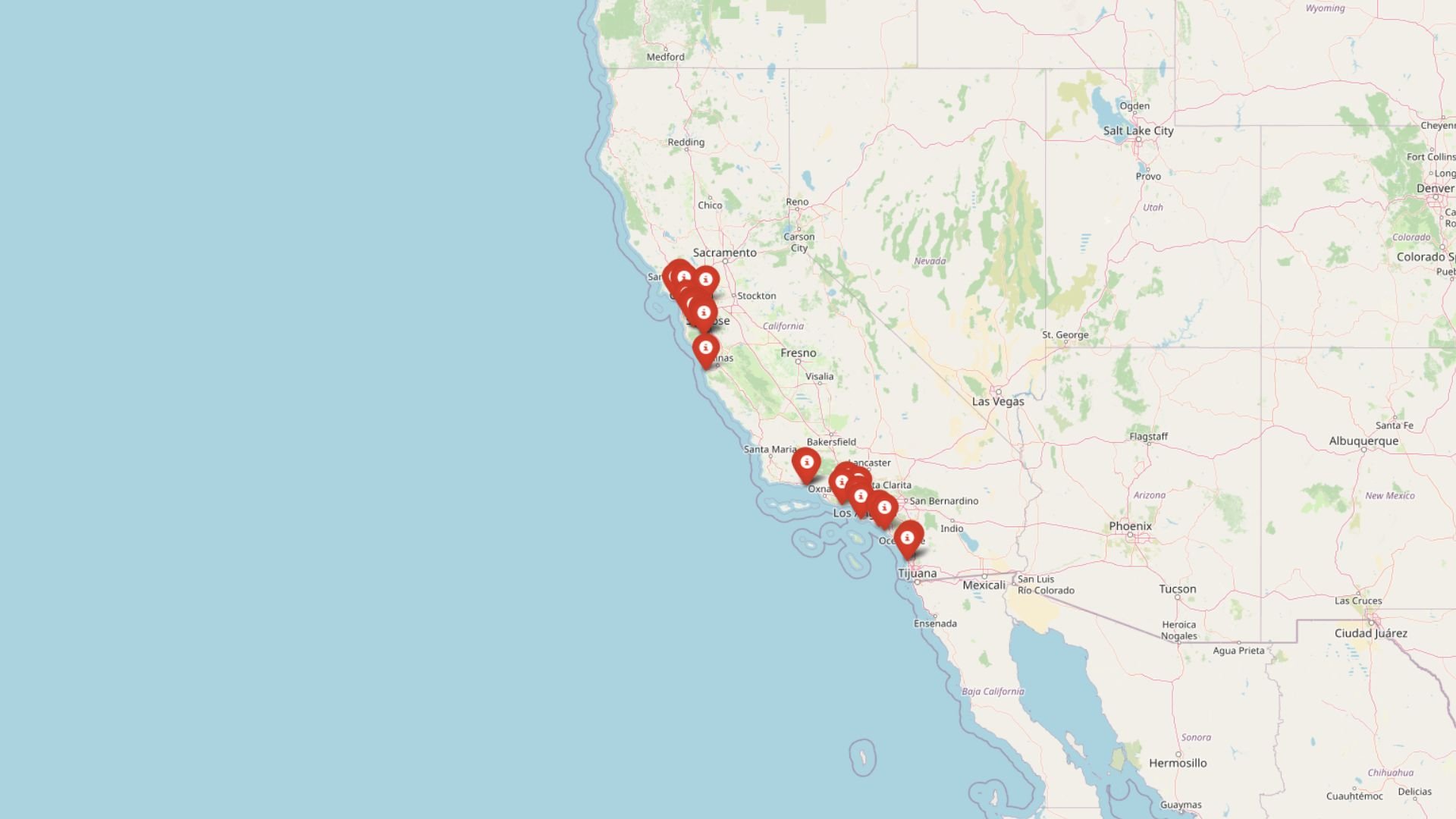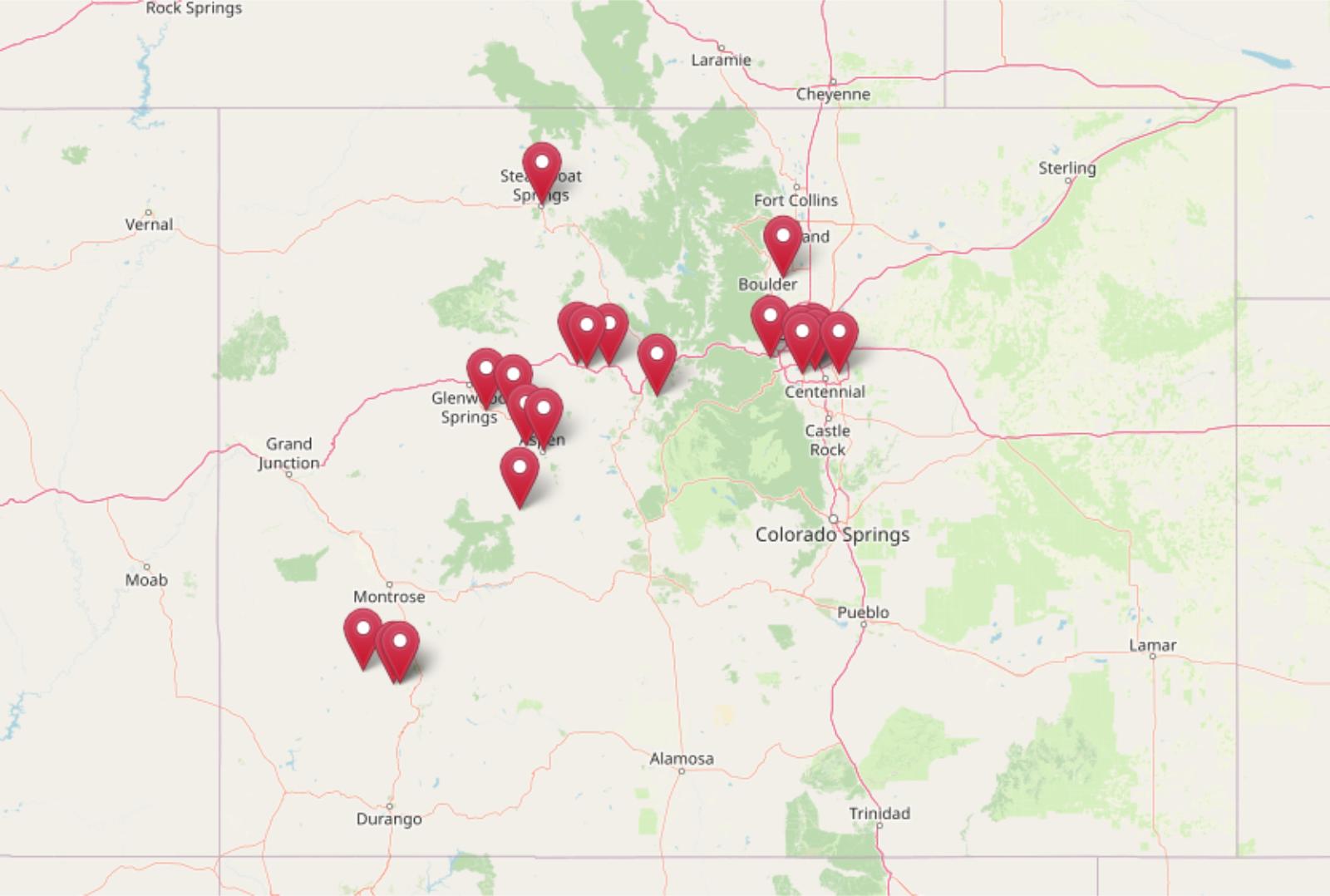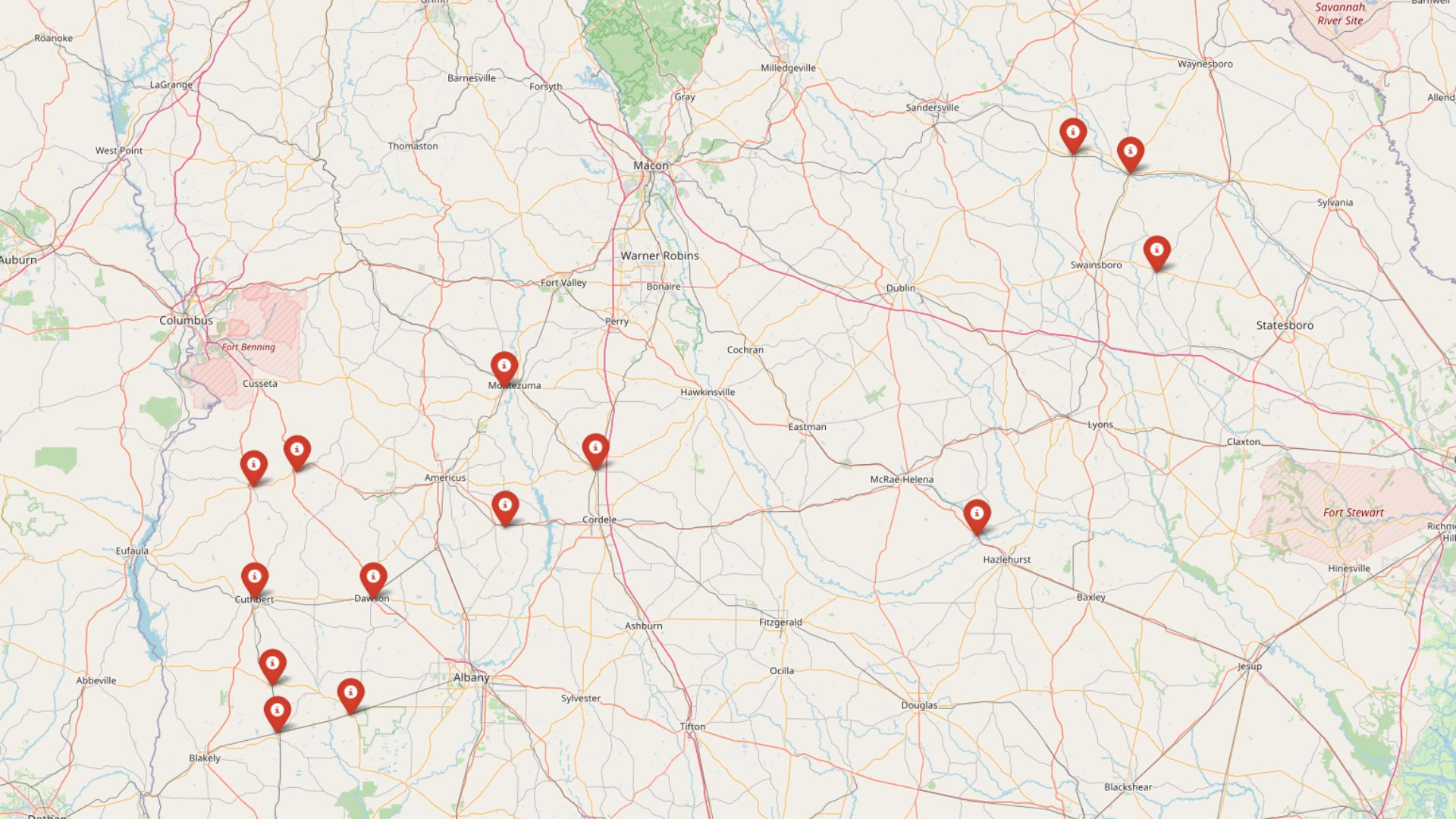
While Georgia’s biggest cities are chasing record highs, a surprising number of towns are quietly staying affordable. The latest data from the Zillow Home Value Index reveals 16 Georgia communities where home prices are still within reach—even as statewide demand pushes costs up. From slow-growing mountain towns to small cities with overlooked potential, these places are keeping things reasonable without losing their Southern charm.
16. Attapulgus – 17.0% Home Price Decline Since 2022
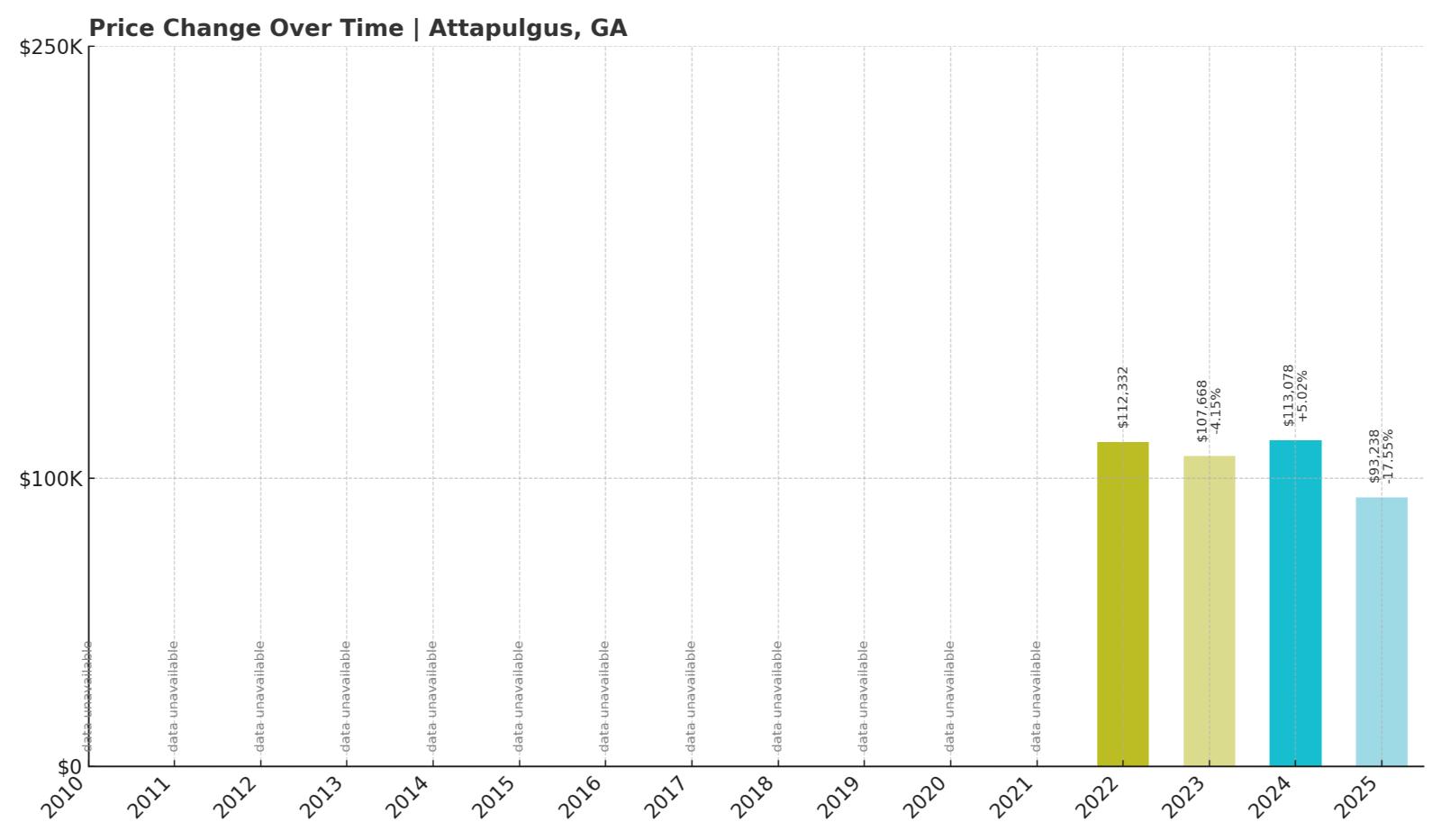
- 2010: N/A
- 2011: N/A
- 2012: N/A
- 2013: N/A
- 2014: N/A
- 2015: N/A
- 2016: N/A
- 2017: N/A
- 2018: N/A
- 2019: N/A
- 2020: N/A
- 2021: N/A
- 2022: $112,332
- 2023: $107,668 (-$4,664, -4.15% from previous year)
- 2024: $113,078 (+$5,410, +5.02% from previous year)
- 2025: $93,238 (-$19,839, -17.54% from previous year)
Attapulgus has seen home values swing dramatically in just a few short years. Prices peaked in 2024 at $113,078, only to fall by more than 17% in the following year to $93,238. This recent drop marks the steepest decline among Georgia’s 16 most affordable towns and puts Attapulgus back below its 2022 valuation. It’s a sharp reversal that might point to deeper regional shifts or simply a cooling correction after temporary spikes.
Attapulgus – Southwest Georgia Town With Big Price Swings
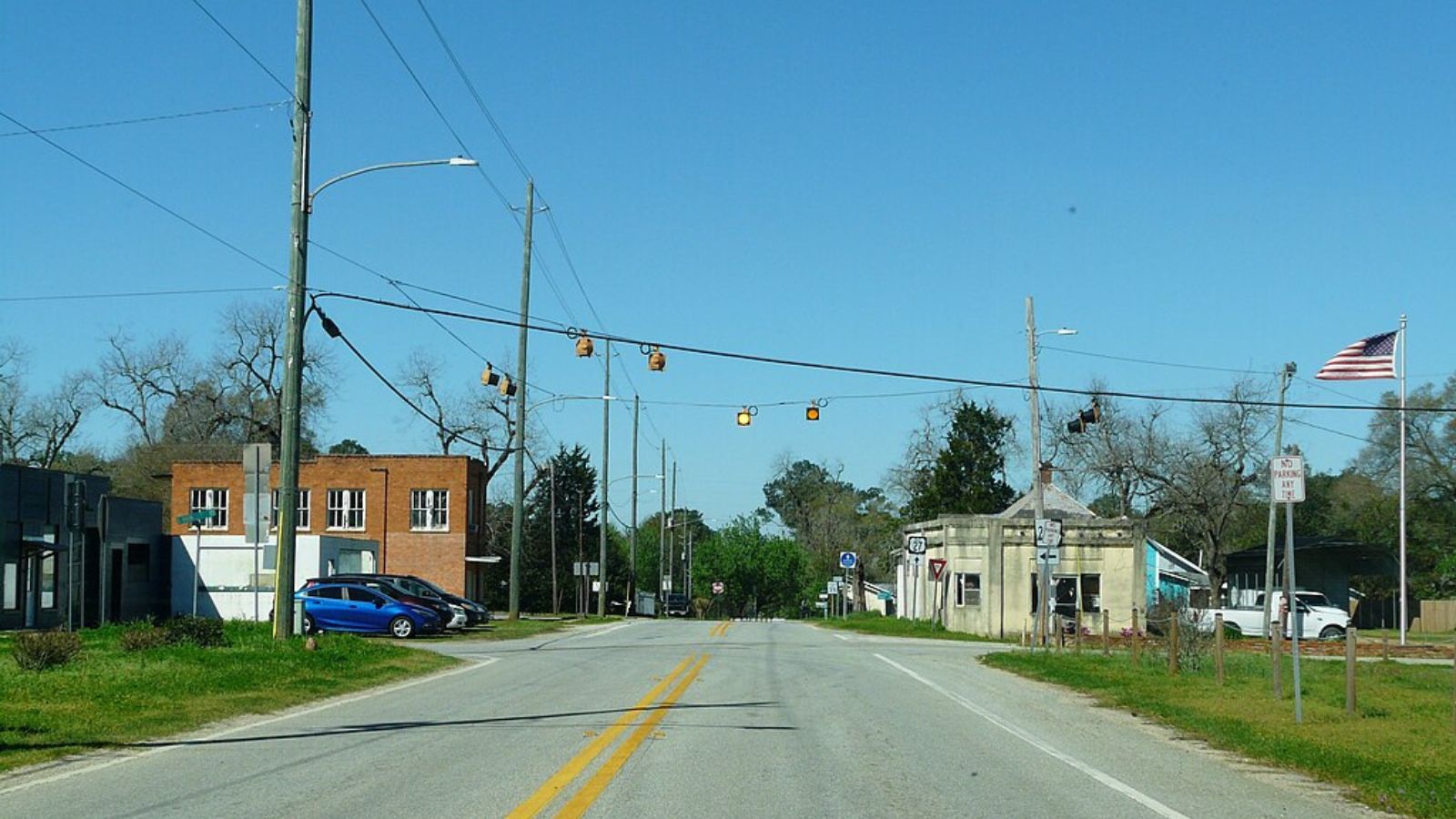
Located in Decatur County near the Florida border, Attapulgus is a small town of fewer than 500 residents. Known for its proximity to agricultural hubs and the Attapulgus Clay Company (which mines attapulgite clay used in many industrial applications), the town has few large employers but offers a quiet, rural lifestyle. With prices now dipping back into the low $90,000s, Attapulgus represents one of the most inexpensive housing markets in the state.
While its limited size and job market may explain the recent decline, the town’s affordability and proximity to Bainbridge or Tallahassee could make it an attractive option for buyers willing to commute or looking for investment property in a stable rural market.
15. Vienna – 48.0% Home Price Increase Since 2010
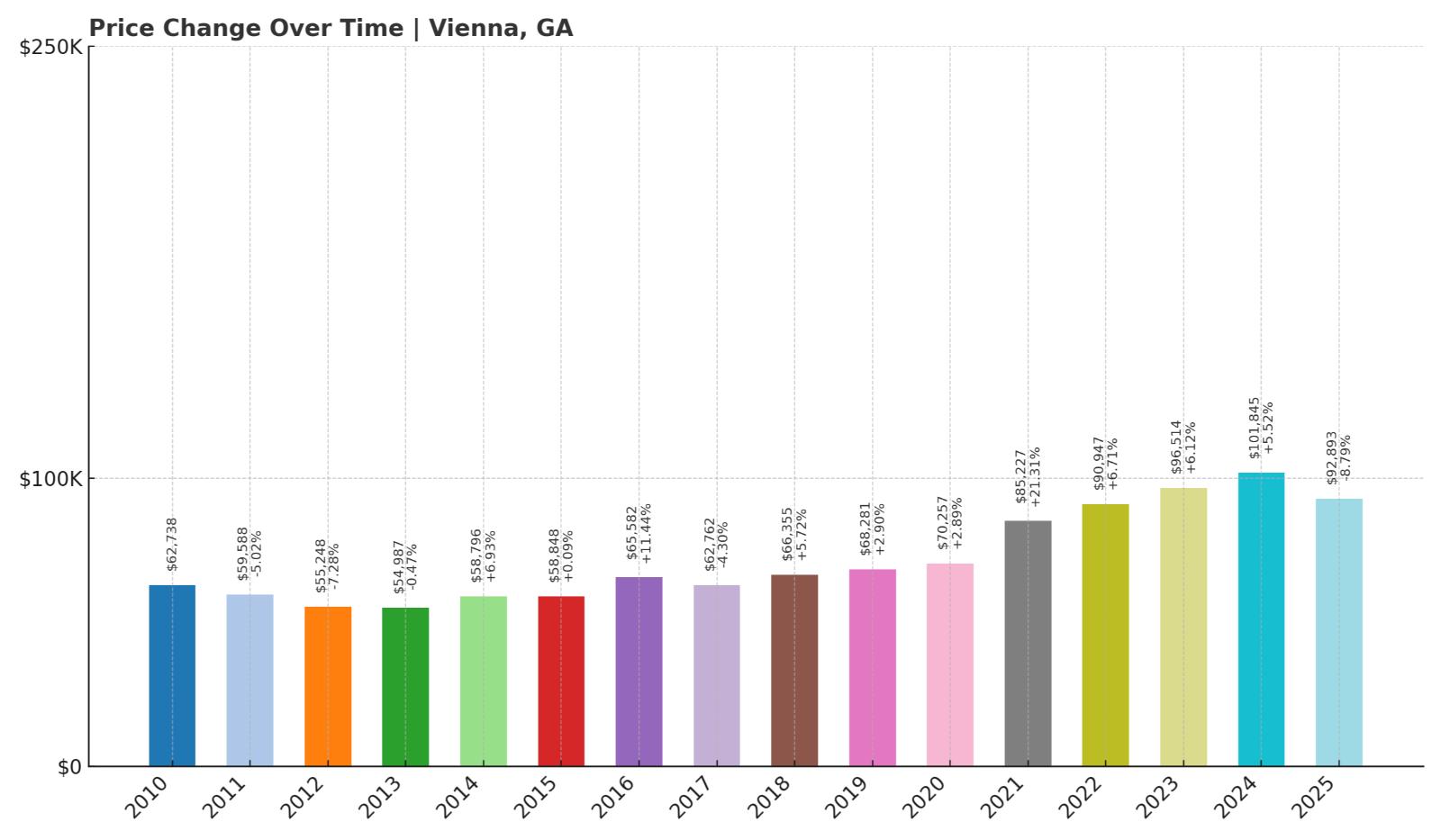
- 2010: $62,738
- 2011: $59,588 (-$3,150, -5.02% from previous year)
- 2012: $55,248 (-$4,339, -7.28% from previous year)
- 2013: $54,987 (-$261, -0.47% from previous year)
- 2014: $58,796 (+$3,809, +6.93% from previous year)
- 2015: $58,848 (+$51, +0.09% from previous year)
- 2016: $65,582 (+$6,734, +11.44% from previous year)
- 2017: $62,762 (-$2,820, -4.30% from previous year)
- 2018: $66,355 (+$3,594, +5.73% from previous year)
- 2019: $68,281 (+$1,926, +2.90% from previous year)
- 2020: $70,257 (+$1,976, +2.89% from previous year)
- 2021: $85,227 (+$14,970, +21.31% from previous year)
- 2022: $90,947 (+$5,720, +6.71% from previous year)
- 2023: $96,514 (+$5,567, +6.12% from previous year)
- 2024: $101,845 (+$5,331, +5.52% from previous year)
- 2025: $92,893 (-$8,952, -8.79% from previous year)
Vienna has experienced long-term price growth of nearly 50% since 2010, although the past year brought a nearly 9% drop from its 2024 peak of $101,845. Despite that recent decline, its 2025 value of $92,893 still places it firmly among Georgia’s most affordable communities.
Vienna – Historic Heart of Dooly County
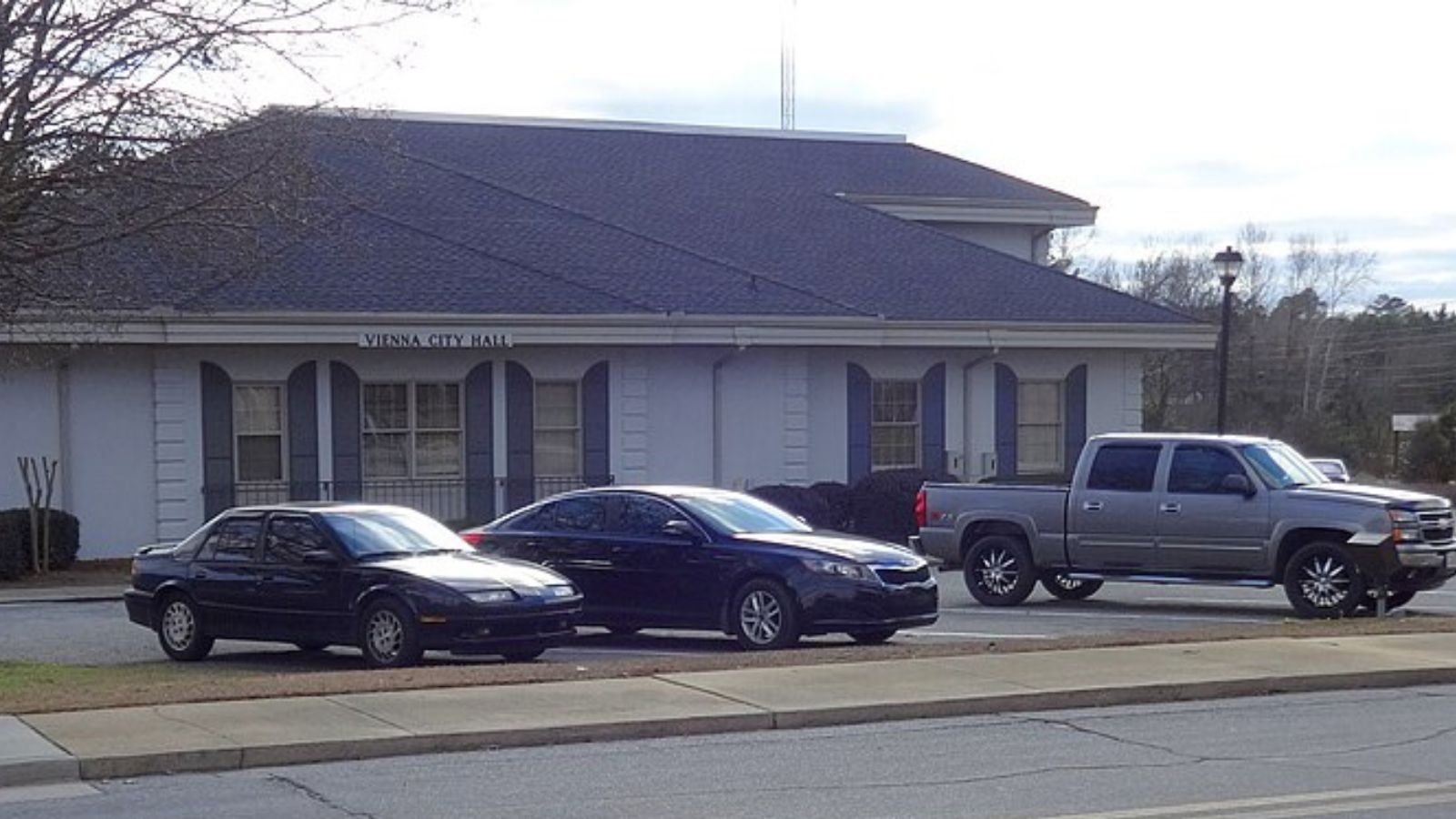
Vienna, the county seat of Dooly County in south-central Georgia, blends historic charm with agricultural roots. The town hosts the annual Big Pig Jig barbecue festival, drawing visitors statewide. Although small, Vienna’s population has held steady, supported by local schools and a modest downtown area.
The steady appreciation from 2015 through 2022 suggests growing appeal among buyers looking for affordable alternatives in central Georgia. The 2025 price dip could reflect short-term market fluctuations, but Vienna remains a stable choice for low-cost homeownership with room for long-term growth.
14. Edison – 22.2% Home Price Decline Since 2023
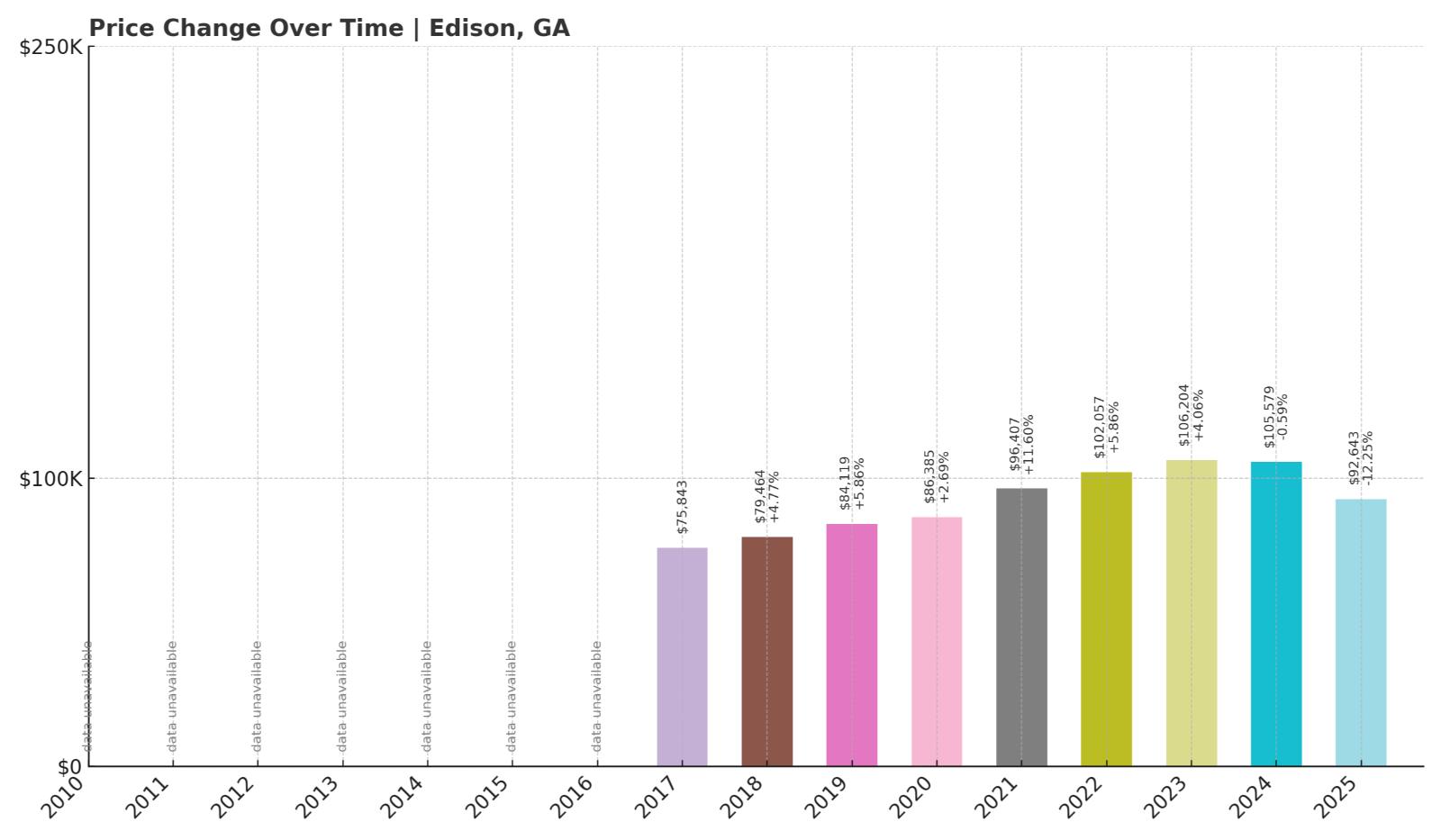
- 2010: N/A
- 2011: N/A
- 2012: N/A
- 2013: N/A
- 2014: N/A
- 2015: N/A
- 2016: N/A
- 2017: $75,843
- 2018: $79,464 (+$3,621, +4.77% from previous year)
- 2019: $84,119 (+$4,656, +5.86% from previous year)
- 2020: $86,385 (+$2,266, +2.69% from previous year)
- 2021: $96,407 (+$10,022, +11.60% from previous year)
- 2022: $102,057 (+$5,650, +5.86% from previous year)
- 2023: $106,204 (+$4,147, +4.06% from previous year)
- 2024: $105,579 (-$625, -0.59% from previous year)
- 2025: $92,643 (-$12,936, -12.25% from previous year)
Edison saw consistent growth from 2017 through 2023 before its prices reversed course. In 2025, home values dropped sharply to $92,643—a loss of over $13,000 from two years earlier. Despite the decline, Edison remains more affordable than many Georgia towns, particularly those near metro areas.
Edison – Small Town With a Big Dip
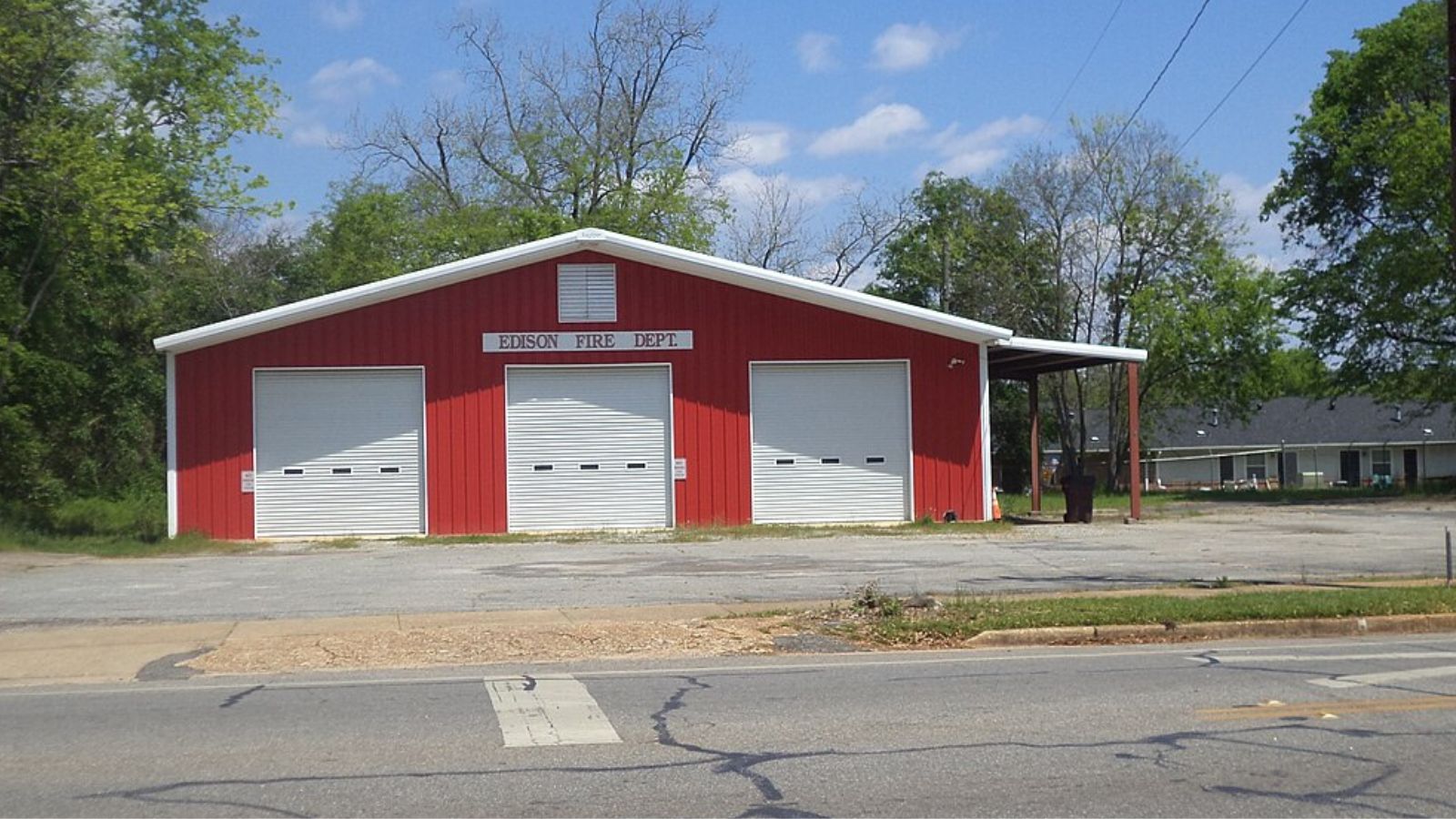
Located in Calhoun County, Edison is a compact town in southwest Georgia. It serves as a local agricultural center and features a walkable grid of streets with quiet residential neighborhoods. Its proximity to Albany offers access to employment while retaining small-town affordability.
The price decline may reflect lower local demand or a rebalancing after years of price gains. Still, for buyers looking for an entry-level market or quiet retirement destination, Edison offers homes well under $100,000 with potential for future appreciation.
13. Lumber City – 11.4% Home Price Decline Since 2024
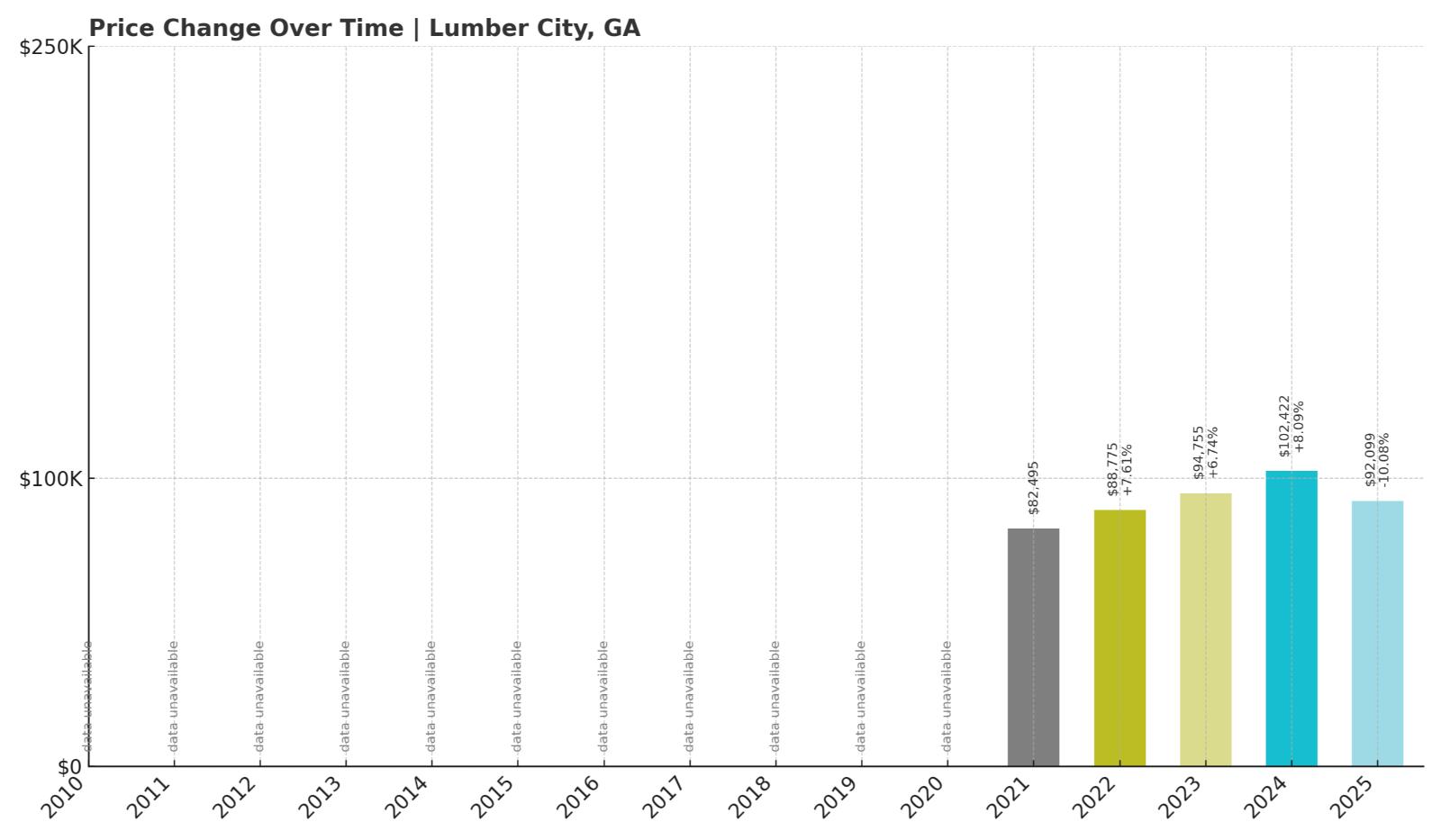
- 2010: N/A
- 2011: N/A
- 2012: N/A
- 2013: N/A
- 2014: N/A
- 2015: N/A
- 2016: N/A
- 2017: N/A
- 2018: N/A
- 2019: N/A
- 2020: N/A
- 2021: $82,495
- 2022: $88,775 (+$6,280, +7.61% from previous year)
- 2023: $94,755 (+$5,980, +6.74% from previous year)
- 2024: $102,422 (+$7,667, +8.09% from previous year)
- 2025: $92,099 (-$10,322, -10.08% from previous year)
After three years of solid growth, Lumber City’s home values fell over 10% in 2025, landing at $92,099. That’s still more than $9,000 above its 2021 level, showing longer-term gains despite recent losses.
Lumber City – Telfair County’s Bargain Buy
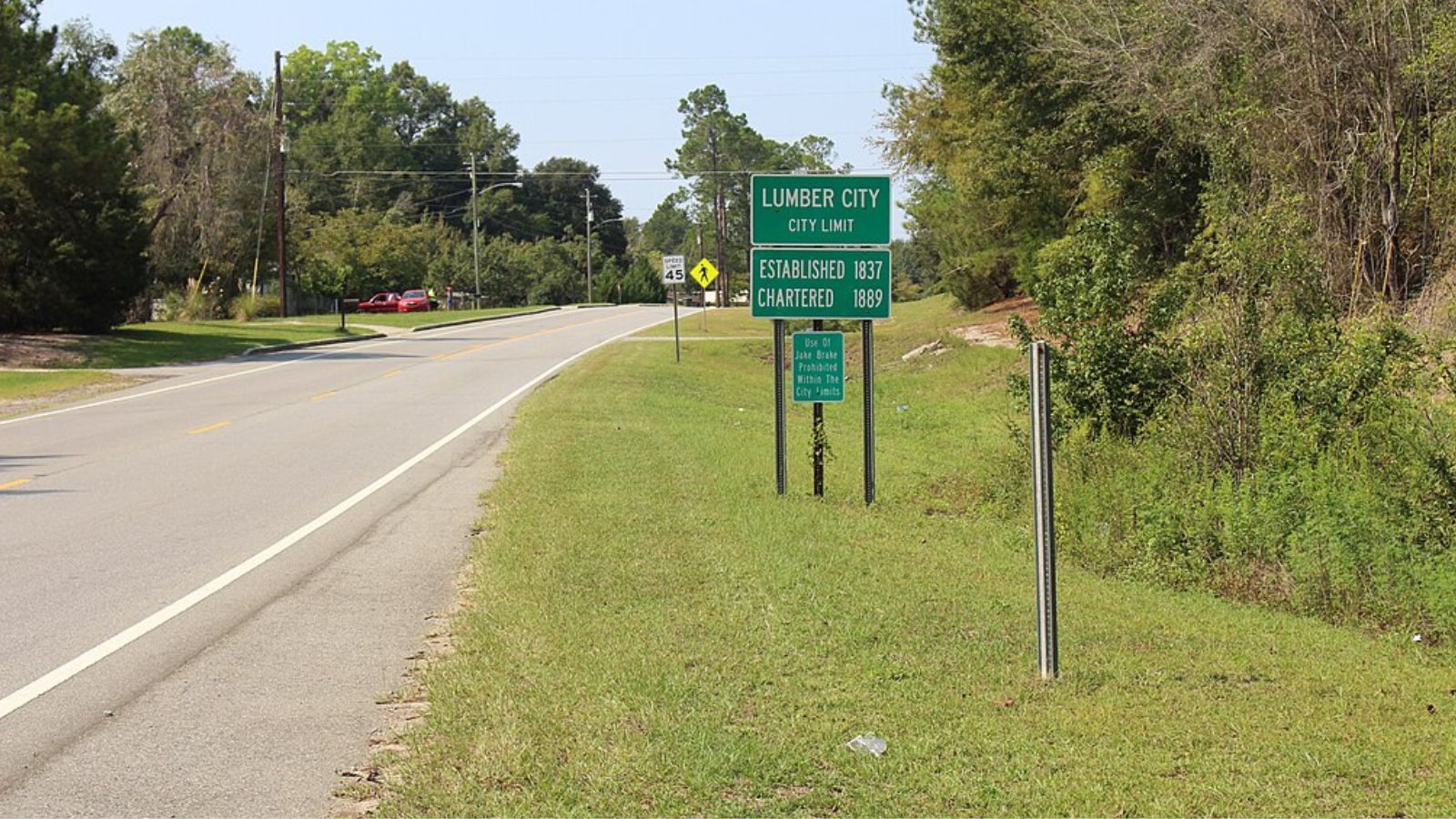
Lumber City lies near the Ocmulgee River in Telfair County and has a population under 1,200. It’s a traditional rural town surrounded by timber operations and farmland. It sits at a crossroads of U.S. Routes 23 and 341, giving it surprisingly good access for a town of its size.
The post-2024 price decline might indicate the cooling of pandemic-era housing activity, but Lumber City remains one of Georgia’s most affordable options for buyers seeking a rural lifestyle with modest pricing and no urban pressure.
12. Statenville – 14.5% Home Price Decline Since 2022
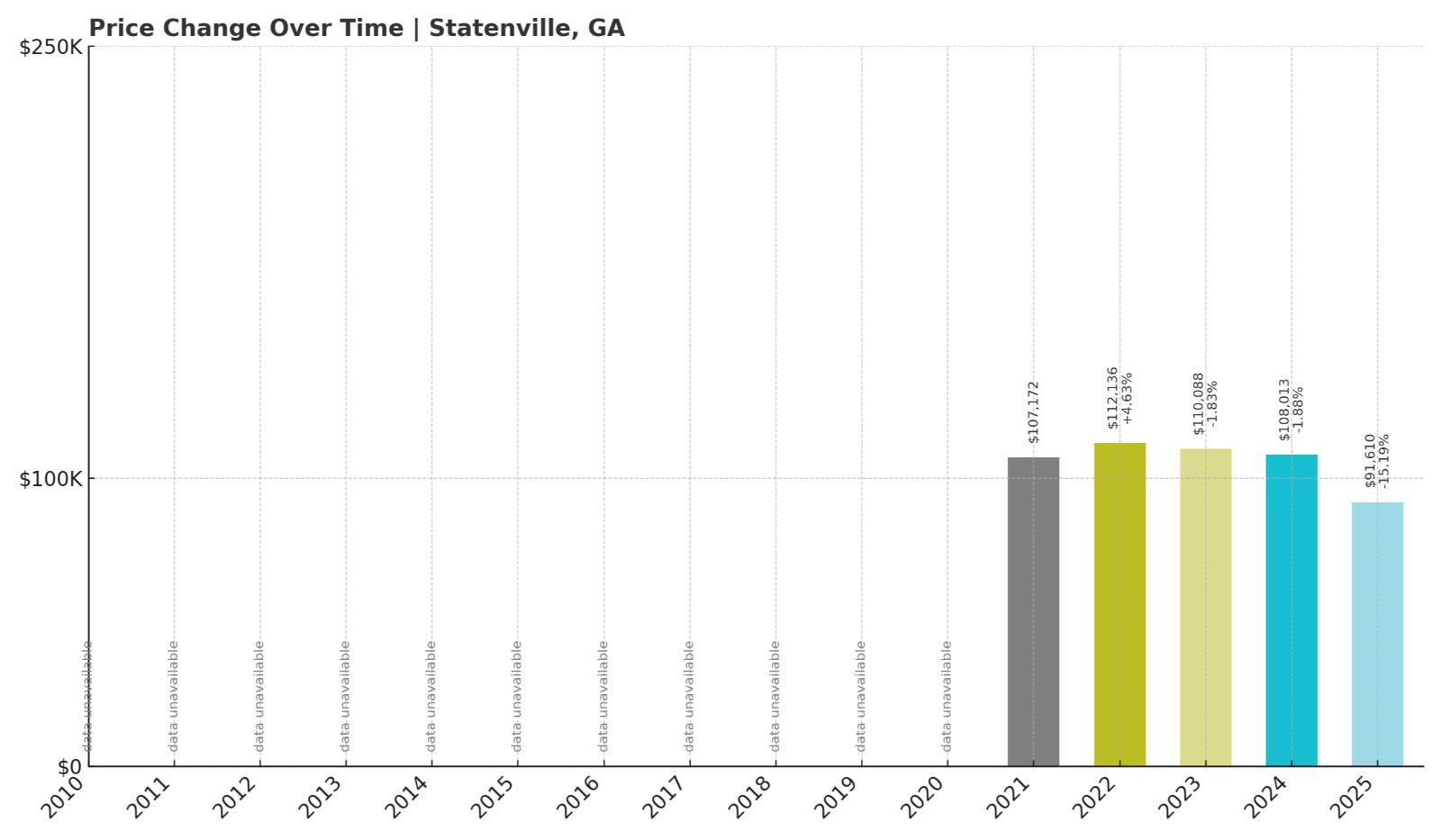
- 2010: N/A
- 2011: N/A
- 2012: N/A
- 2013: N/A
- 2014: N/A
- 2015: N/A
- 2016: N/A
- 2017: N/A
- 2018: N/A
- 2019: N/A
- 2020: N/A
- 2021: $107,172
- 2022: $112,136 (+$4,964, +4.63% from previous year)
- 2023: $110,088 (-$2,049, -1.83% from previous year)
- 2024: $108,013 (-$2,074, -1.88% from previous year)
- 2025: $91,610 (-$16,403, -15.19% from previous year)
Statenville saw home values tumble nearly 16% in 2025 after several years of minor fluctuations. The current median home value of $91,610 is still up from 2021 but suggests a sharp correction that may attract price-conscious buyers.
Statenville – Quiet Living in the Deep South
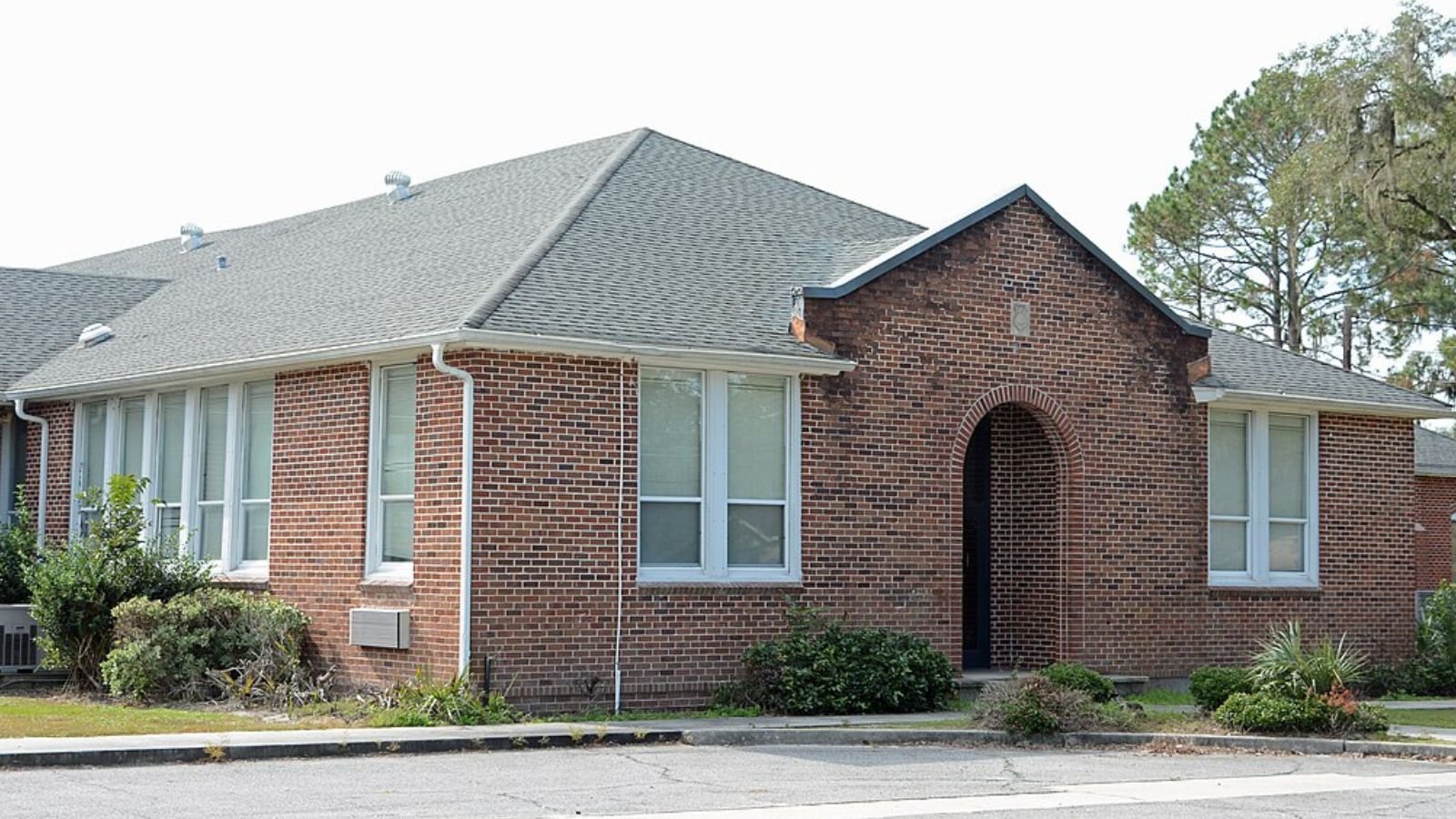
As the only town in Echols County, Statenville is a unique case: it has no incorporated municipalities and serves as the county seat. Located along the Florida border, it’s remote and deeply rural, with the nearest significant cities being Valdosta and Lake City, Florida.
Its housing market may be influenced by limited demand and an aging housing stock. But for buyers seeking low home prices and quiet surroundings, Statenville’s current drop in home values presents an appealing opening.
11. Leary – 14.3% Home Price Decline Since 2022

- 2010: N/A
- 2011: N/A
- 2012: N/A
- 2013: N/A
- 2014: N/A
- 2015: N/A
- 2016: N/A
- 2017: N/A
- 2018: N/A
- 2019: N/A
- 2020: N/A
- 2021: N/A
- 2022: $106,543
- 2023: $105,516 (-$1,028, -0.96% from previous year)
- 2024: $105,726 (+$210, +0.20% from previous year)
- 2025: $91,257 (-$14,468, -13.68% from previous year)
Leary’s home values remained mostly flat from 2022 through 2024, followed by a significant drop of nearly 14% in 2025. With a current median price of $91,257, it now sits well below its recent peak. This drop positions Leary squarely among Georgia’s most affordable towns.
Leary – Agricultural Roots and Recent Price Drops
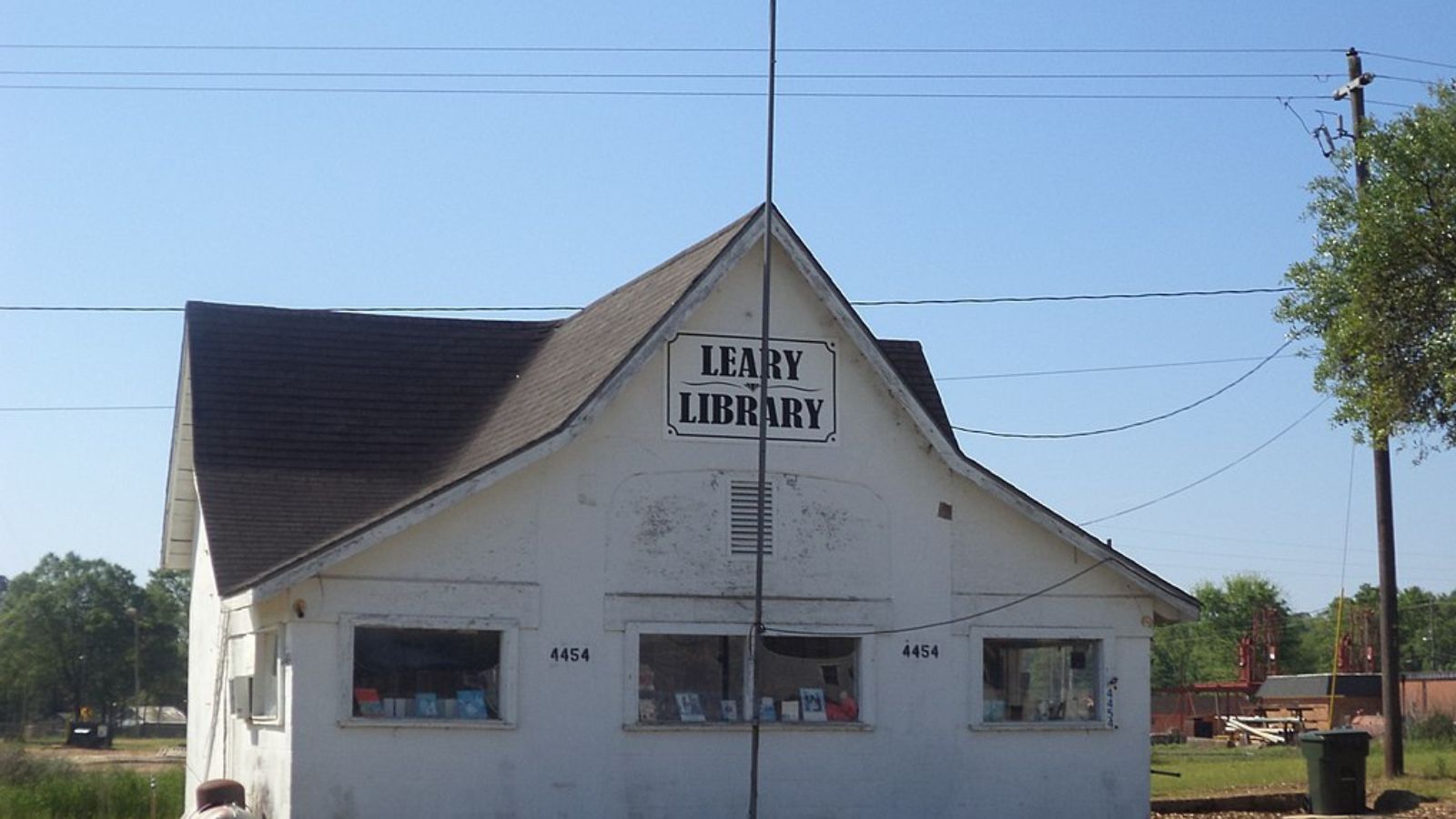
Leary is a small city in Calhoun County, nestled in the heart of southwest Georgia’s agricultural belt. The town is surrounded by farmland and offers minimal commercial development, keeping housing prices consistently low. The sharp decline in 2025 may reflect local economic shifts or limited buyer interest in such rural markets.
Despite its small size, Leary has seen steady values in the past, suggesting some long-term resilience. Its affordability makes it attractive for those seeking investment property or a starter home. However, limited amenities and job opportunities may continue to impact future pricing trends.
10. Oglethorpe – 69.8% Home Price Increase Since 2014
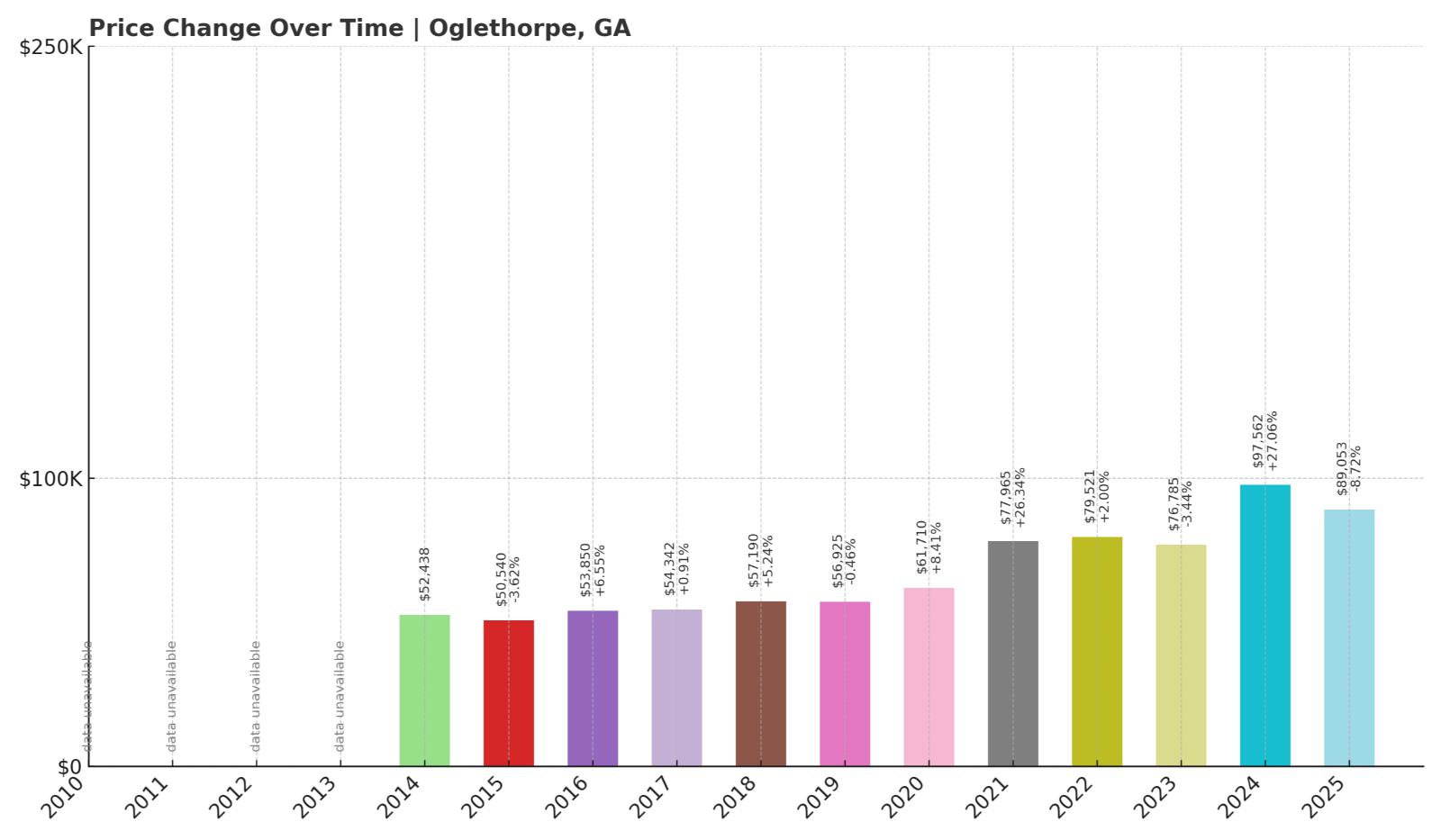
- 2010: N/A
- 2011: N/A
- 2012: N/A
- 2013: N/A
- 2014: $52,438
- 2015: $50,540 (-$1,898, -3.62% from previous year)
- 2016: $53,850 (+$3,310, +6.55% from previous year)
- 2017: $54,342 (+$492, +0.91% from previous year)
- 2018: $57,190 (+$2,848, +5.24% from previous year)
- 2019: $56,925 (-$265, -0.46% from previous year)
- 2020: $61,710 (+$4,784, +8.40% from previous year)
- 2021: $77,965 (+$16,256, +26.34% from previous year)
- 2022: $79,521 (+$1,556, +2.00% from previous year)
- 2023: $76,785 (-$2,737, -3.44% from previous year)
- 2024: $97,562 (+$20,777, +27.06% from previous year)
- 2025: $89,053 (-$8,509, -8.72% from previous year)
Oglethorpe’s housing market has seen major movement in the past decade, with a nearly 70% increase since 2014. Home prices soared in 2024 before pulling back slightly in 2025 to $89,053. Despite the dip, this remains one of the most affordable towns for buyers in Georgia.
Oglethorpe – Macon County’s Affordable Hub

Oglethorpe sits in central Georgia and serves as the county seat of Macon County. It offers a mix of older housing and modest community infrastructure, with a population under 1,500. Price gains in 2021 and 2024 reflect some buyer interest, but affordability remains strong overall.
The 2025 decline may point to volatility or corrections following growth spurts. Still, with home values well under $100,000, Oglethorpe remains accessible to first-time buyers. It’s especially appealing to those looking for quiet communities with lower living costs.
9. Arlington – 44.7% Home Price Increase Since 2010
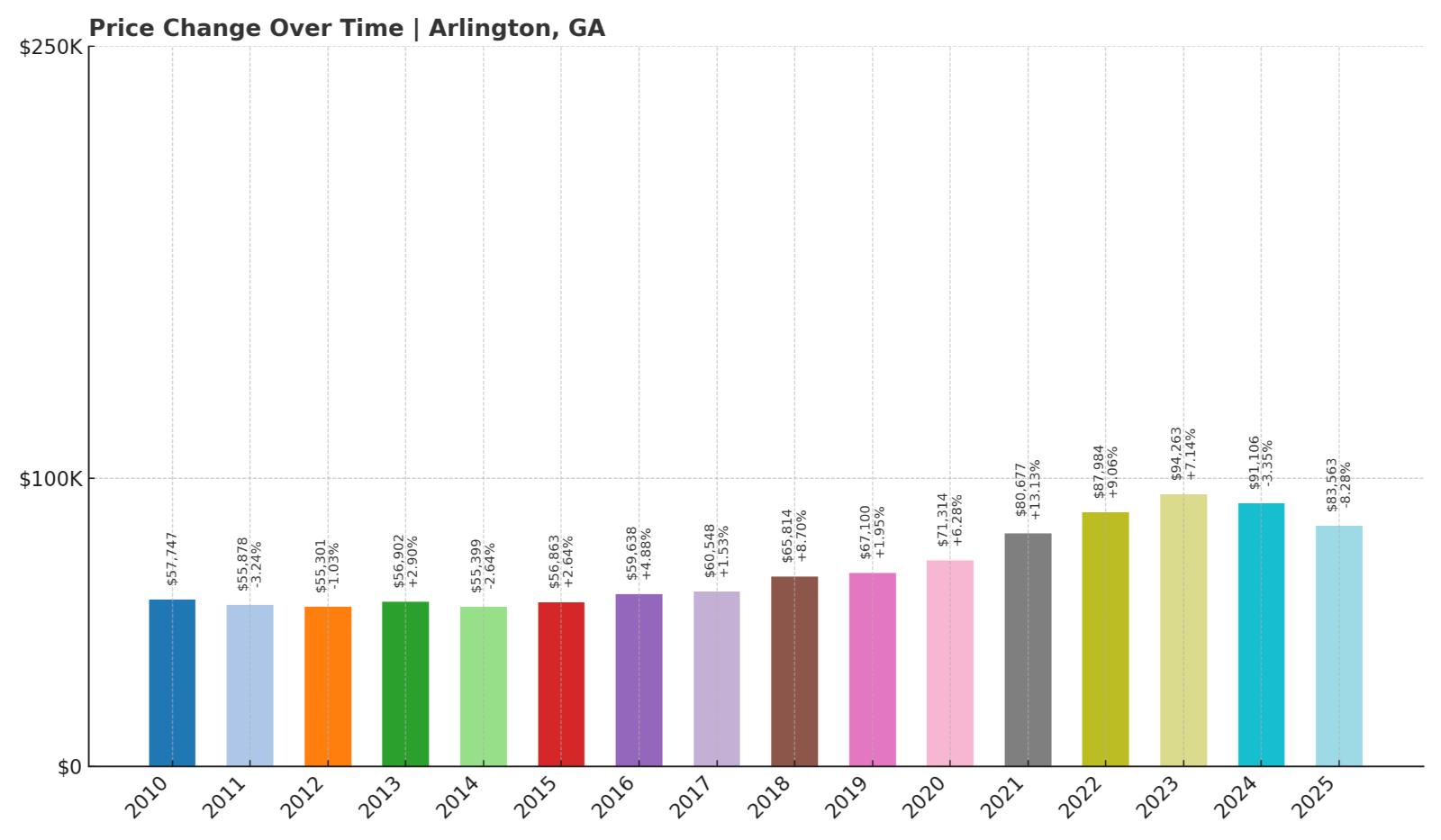
- 2010: $57,747
- 2011: $55,878 (-$1,869, -3.24% from previous year)
- 2012: $55,301 (-$577, -1.03% from previous year)
- 2013: $56,902 (+$1,601, +2.89% from previous year)
- 2014: $55,399 (-$1,503, -2.64% from previous year)
- 2015: $56,863 (+$1,464, +2.64% from previous year)
- 2016: $59,638 (+$2,774, +4.88% from previous year)
- 2017: $60,548 (+$911, +1.53% from previous year)
- 2018: $65,814 (+$5,266, +8.70% from previous year)
- 2019: $67,100 (+$1,286, +1.95% from previous year)
- 2020: $71,314 (+$4,214, +6.28% from previous year)
- 2021: $80,677 (+$9,363, +13.13% from previous year)
- 2022: $87,984 (+$7,307, +9.06% from previous year)
- 2023: $94,263 (+$6,280, +7.14% from previous year)
- 2024: $91,106 (-$3,157, -3.35% from previous year)
- 2025: $83,563 (-$7,543, -8.28% from previous year)
Arlington’s home values grew steadily over the last 15 years, increasing nearly 45% since 2010. Prices peaked in 2023 and have since declined by more than $10,000. The 2025 value of $83,563 keeps Arlington well within reach for budget-conscious buyers.
Arlington – Long-Term Gains With Recent Dips
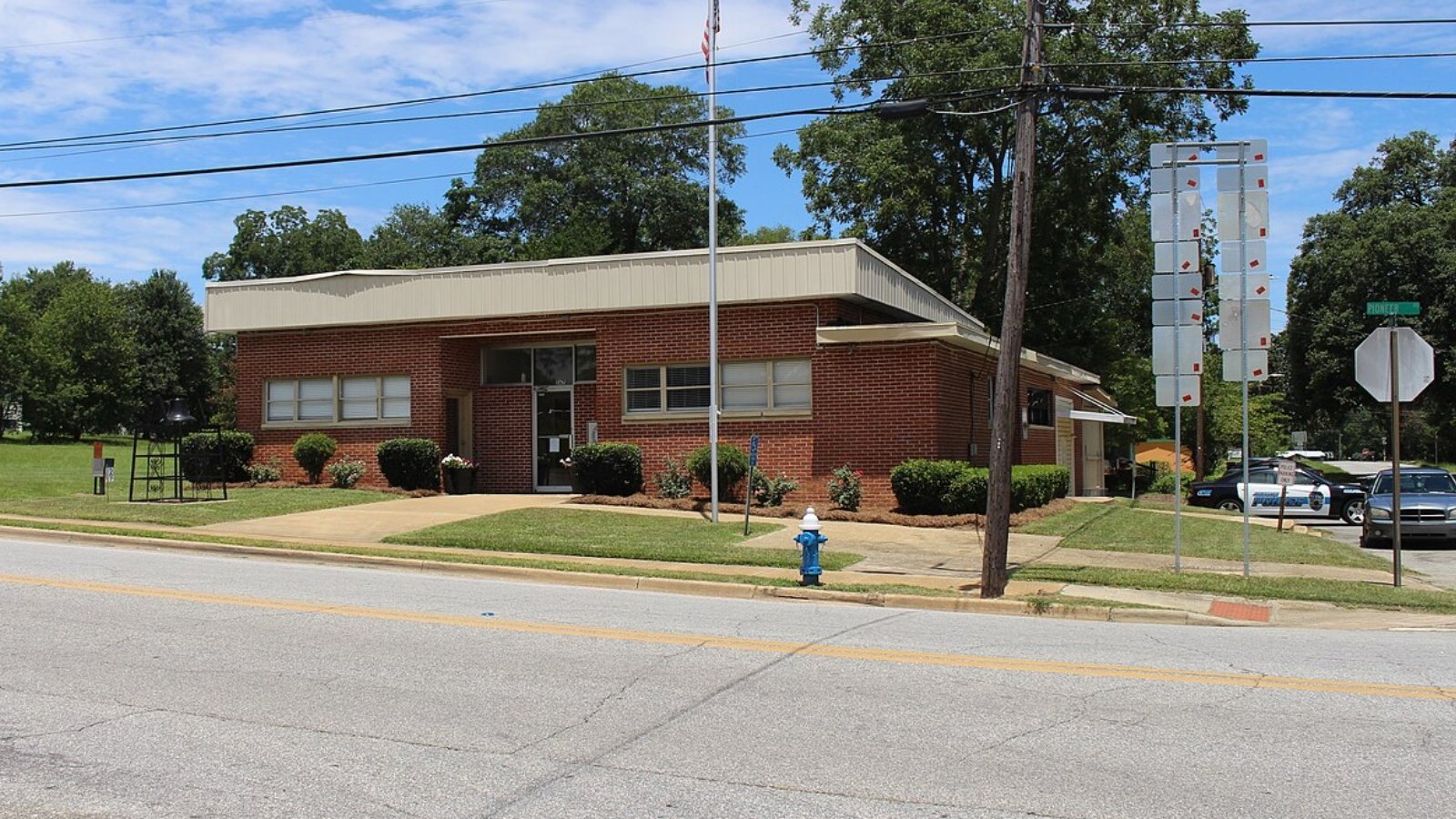
Located in both Calhoun and Early counties, Arlington is a small town with a rural setting and limited development. It sits roughly halfway between Albany and Dothan, Alabama, and its economy is anchored by agriculture and small businesses. The town’s housing market has expanded slowly but consistently over the last decade.
The recent pullback in prices could be a reflection of economic uncertainty or overvaluation in prior years. Still, Arlington’s relatively low cost and long history of gradual gains may reassure cautious buyers. For those seeking long-term affordability with potential upside, it remains a strong option.
8. Twin City – 74.3% Home Price Increase Since 2010
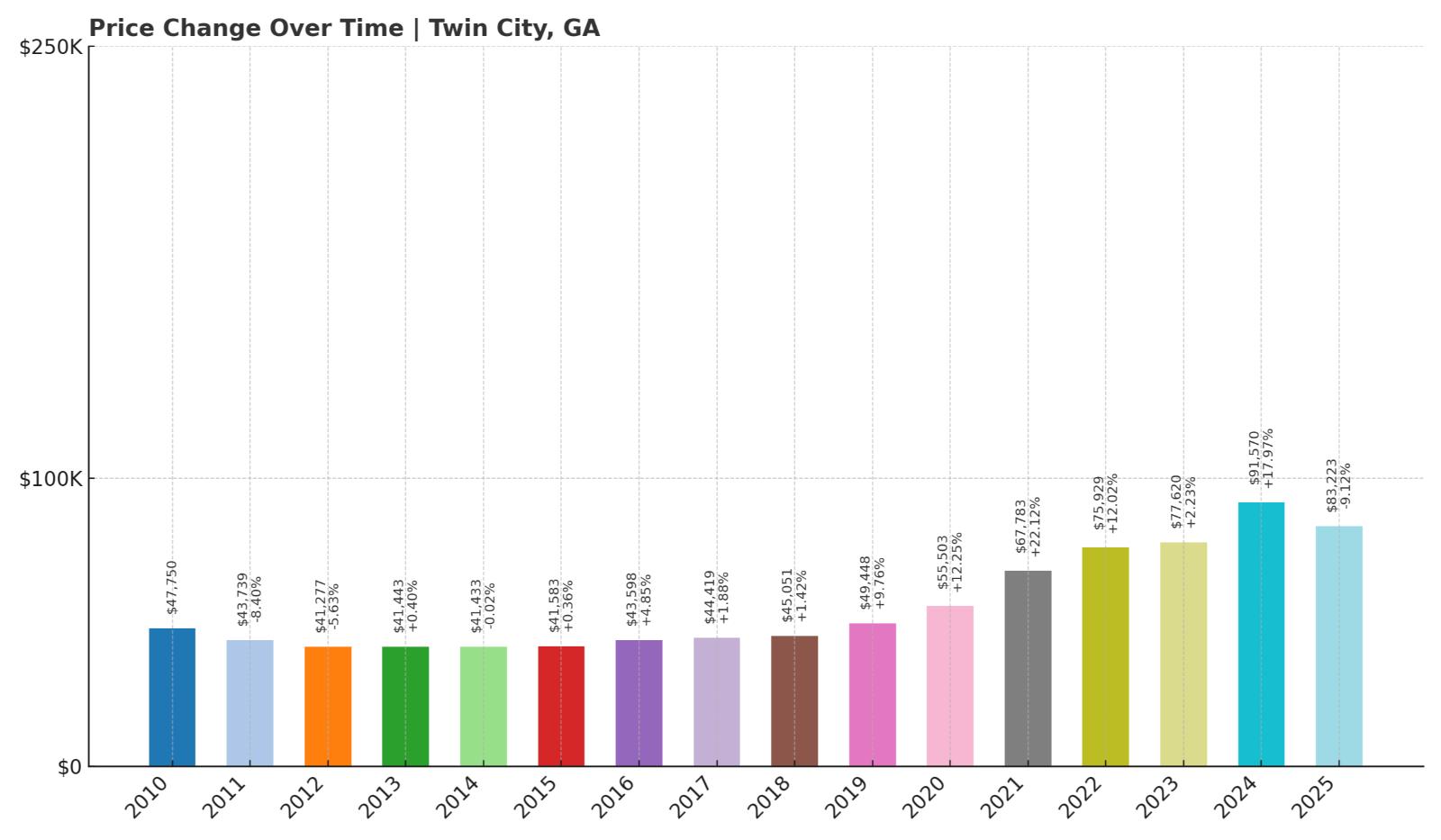
- 2010: $47,750
- 2011: $43,739 (-$4,011, -8.40% from previous year)
- 2012: $41,277 (-$2,462, -5.63% from previous year)
- 2013: $41,443 (+$166, +0.40% from previous year)
- 2014: $41,433 (-$10, -0.02% from previous year)
- 2015: $41,583 (+$149, +0.36% from previous year)
- 2016: $43,598 (+$2,016, +4.85% from previous year)
- 2017: $44,419 (+$821, +1.88% from previous year)
- 2018: $45,051 (+$632, +1.42% from previous year)
- 2019: $49,448 (+$4,397, +9.76% from previous year)
- 2020: $55,503 (+$6,055, +12.25% from previous year)
- 2021: $67,783 (+$12,280, +22.12% from previous year)
- 2022: $75,929 (+$8,146, +12.02% from previous year)
- 2023: $77,620 (+$1,691, +2.23% from previous year)
- 2024: $91,570 (+$13,950, +17.97% from previous year)
- 2025: $83,223 (-$8,346, -9.11% from previous year)
Twin City has posted substantial gains since 2010, with home prices growing more than 70% over that period. The most dramatic surge came in 2024, followed by a near 10% correction in 2025. Still, with a current value of $83,223, it remains one of Georgia’s least expensive towns.
Twin City – Steady Growth in Emanuel County
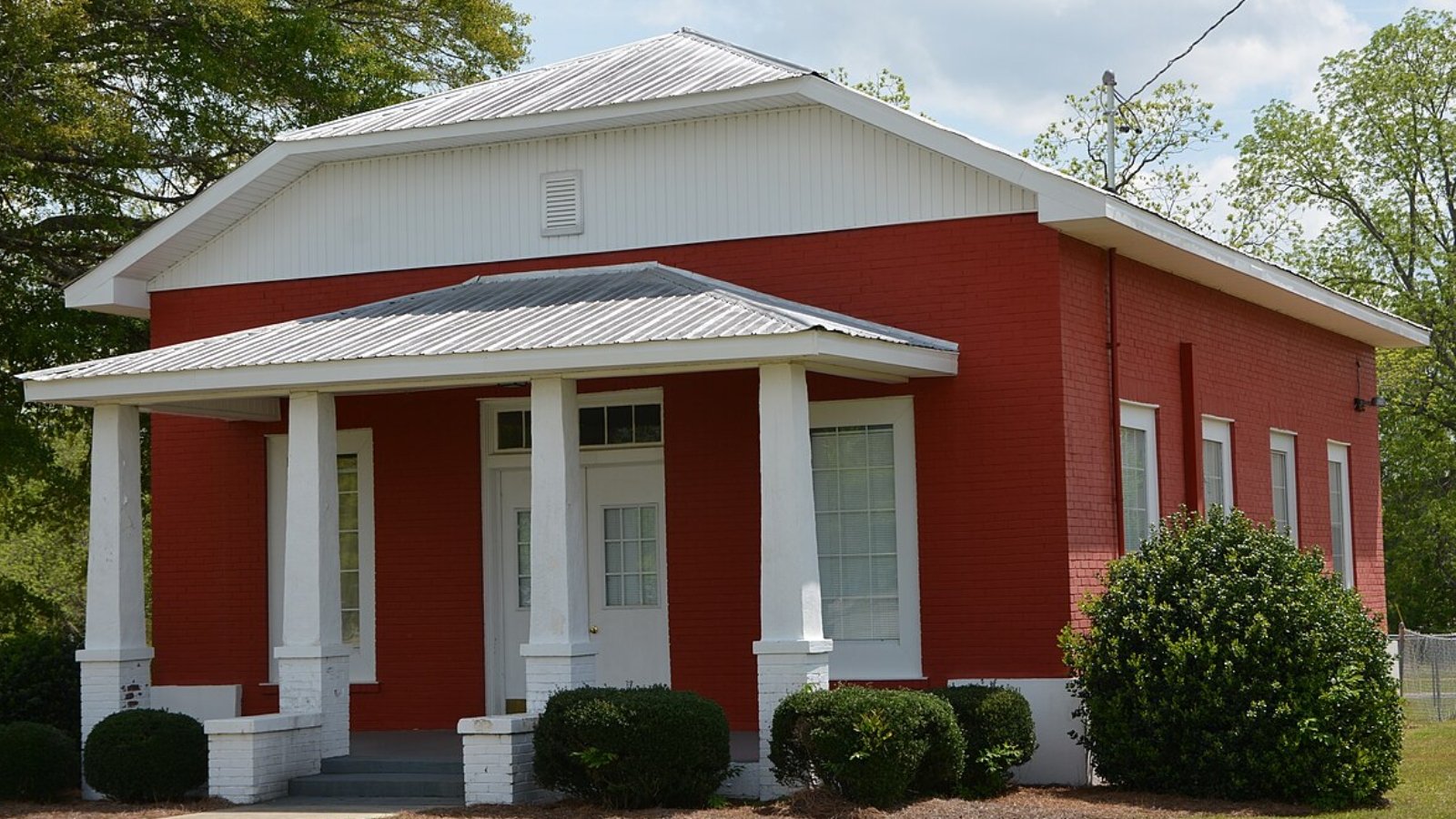
Formed by merging Graymont and Summit in 1921, Twin City is located in Emanuel County in eastern Georgia. It’s a tight-knit community with historical buildings and small-town charm, close to George L. Smith State Park. With low living costs and rural appeal, it’s drawn slow but consistent buyer interest in recent years.
The recent decline in home values likely reflects a recalibration after rapid growth. Even so, prices remain low compared to most of the state. Twin City is ideal for buyers looking for value and peaceful surroundings without straying too far from Savannah or Augusta.
7. Dawson – 110.0% Home Price Increase Since 2010
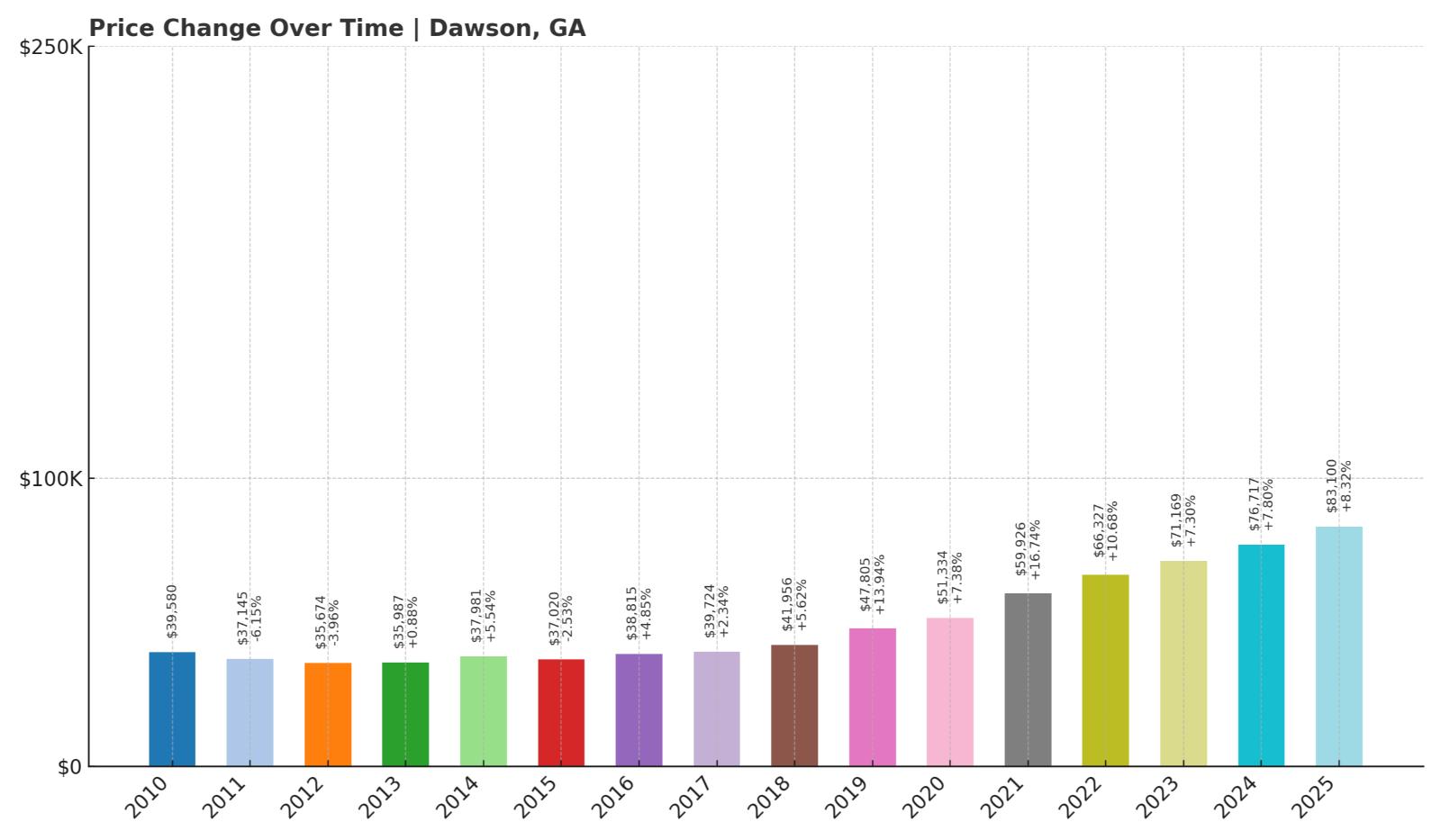
- 2010: $39,580
- 2011: $37,145 (-$2,435, -6.15% from previous year)
- 2012: $35,674 (-$1,471, -3.96% from previous year)
- 2013: $35,987 (+$313, +0.88% from previous year)
- 2014: $37,981 (+$1,994, +5.54% from previous year)
- 2015: $37,020 (-$961, -2.53% from previous year)
- 2016: $38,815 (+$1,795, +4.85% from previous year)
- 2017: $39,724 (+$910, +2.34% from previous year)
- 2018: $41,956 (+$2,232, +5.62% from previous year)
- 2019: $47,805 (+$5,849, +13.94% from previous year)
- 2020: $51,334 (+$3,529, +7.38% from previous year)
- 2021: $59,926 (+$8,592, +16.74% from previous year)
- 2022: $66,327 (+$6,402, +10.68% from previous year)
- 2023: $71,169 (+$4,841, +7.30% from previous year)
- 2024: $76,717 (+$5,549, +7.80% from previous year)
- 2025: $83,100 (+$6,382, +8.32% from previous year)
Dawson’s home values have more than doubled since 2010, increasing from $39,580 to $83,100 in 2025. Prices have climbed steadily year over year, with no recorded annual declines in the last decade. Despite this growth, Dawson remains one of Georgia’s most affordable towns, with homes still well below the state median.
Dawson – A Rising Market That’s Still Budget-Friendly

Located in Terrell County, Dawson is about 20 miles northwest of Albany in southwest Georgia. It has long served as a regional hub for agriculture and small-scale manufacturing, though recent years have brought slow population decline. That hasn’t stopped home prices from climbing steadily, indicating growing interest in its affordable housing stock.
With values rising each year since 2013, Dawson stands out as a town with long-term upward momentum. Even so, its current price point in the low $80,000s is far below statewide averages, making it attractive for buyers priced out of larger markets. The town’s combination of affordability and consistent growth may appeal to first-time homeowners and investors alike.
6. De Soto – 5.6% Home Price Increase Since 2010
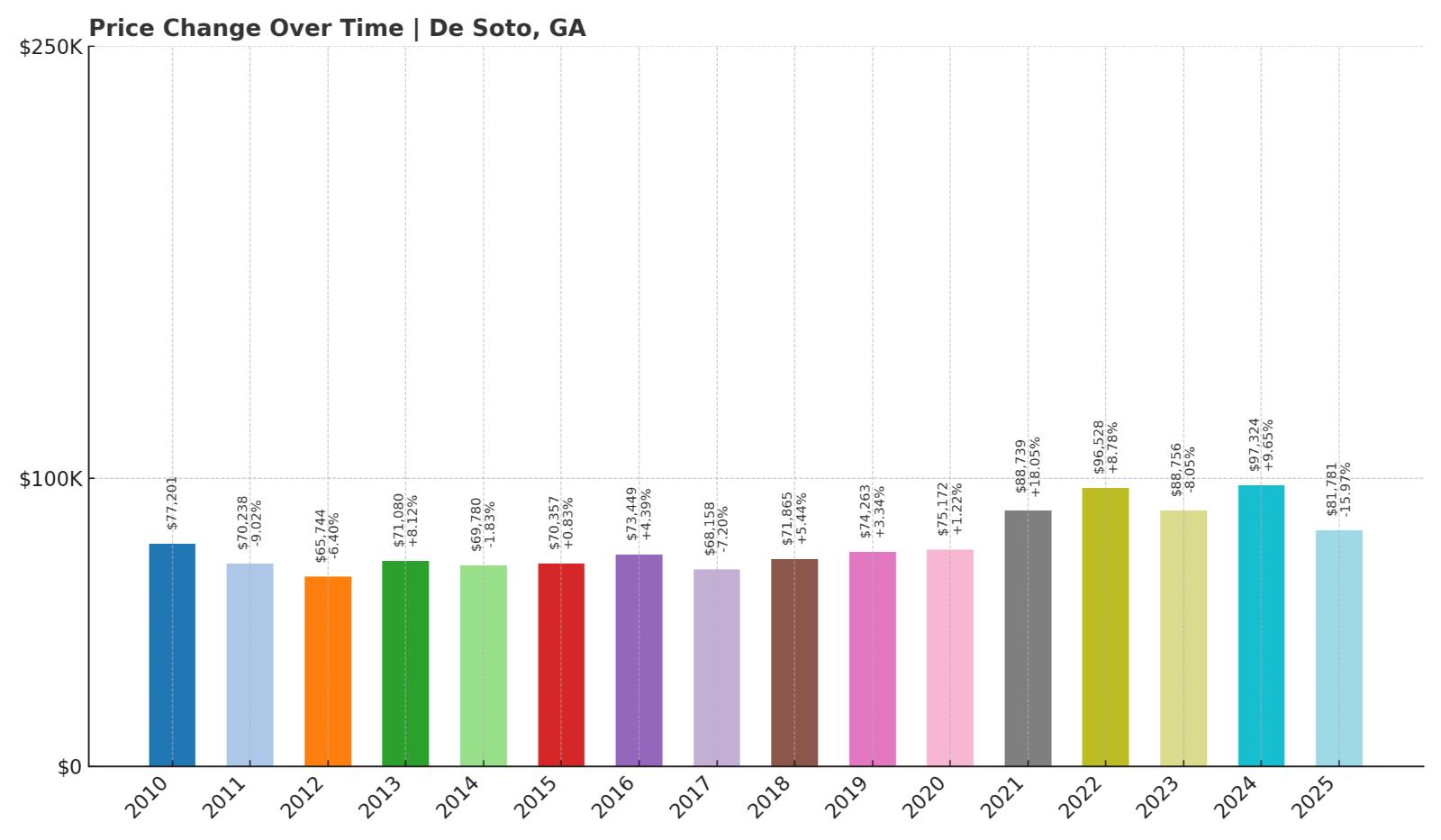
- 2010: $77,201
- 2011: $70,238 (-$6,962, -9.02% from previous year)
- 2012: $65,744 (-$4,494, -6.40% from previous year)
- 2013: $71,080 (+$5,336, +8.12% from previous year)
- 2014: $69,780 (-$1,300, -1.83% from previous year)
- 2015: $70,357 (+$577, +0.83% from previous year)
- 2016: $73,449 (+$3,092, +4.39% from previous year)
- 2017: $68,158 (-$5,290, -7.20% from previous year)
- 2018: $71,865 (+$3,706, +5.44% from previous year)
- 2019: $74,263 (+$2,398, +3.34% from previous year)
- 2020: $75,172 (+$910, +1.22% from previous year)
- 2021: $88,739 (+$13,567, +18.05% from previous year)
- 2022: $96,528 (+$7,789, +8.78% from previous year)
- 2023: $88,756 (-$7,772, -8.05% from previous year)
- 2024: $97,324 (+$8,568, +9.65% from previous year)
- 2025: $81,781 (-$15,543, -15.97% from previous year)
Home prices in De Soto have fluctuated significantly over the years, but the overall growth since 2010 is modest at just 5.6%. After a sharp drop in 2025, values now sit at $81,781, nearly $16,000 down from the previous year. Even so, De Soto remains comfortably within Georgia’s cheapest tier of towns.
De Soto – Rollercoaster Pricing in Rural Sumter County

De Soto is a tiny city in Sumter County with a population of fewer than 200 people. It’s located between Americus and Cordele, making it a rural enclave with limited economic drivers. That isolation likely contributes to the market volatility seen in recent years.
Despite the ups and downs, prices here have not exceeded $100,000 at any point in the data set. This makes De Soto one of the rare towns in Georgia where affordability is almost guaranteed. Buyers seeking deep discounts and aren’t put off by remote living might find it worth a closer look.
5. Richland – 57.6% Home Price Increase Since 2010

- 2010: $48,505
- 2011: $44,423 (-$4,082, -8.42% from previous year)
- 2012: $40,213 (-$4,210, -9.48% from previous year)
- 2013: $48,596 (+$8,383, +20.85% from previous year)
- 2014: $54,320 (+$5,724, +11.78% from previous year)
- 2015: $51,877 (-$2,443, -4.50% from previous year)
- 2016: $53,676 (+$1,799, +3.47% from previous year)
- 2017: $50,267 (-$3,409, -6.35% from previous year)
- 2018: $54,284 (+$4,017, +7.99% from previous year)
- 2019: $54,836 (+$551, +1.02% from previous year)
- 2020: $53,391 (-$1,444, -2.63% from previous year)
- 2021: $66,958 (+$13,567, +25.41% from previous year)
- 2022: $75,111 (+$8,153, +12.18% from previous year)
- 2023: $70,448 (-$4,663, -6.21% from previous year)
- 2024: $80,726 (+$10,278, +14.59% from previous year)
- 2025: $76,489 (-$4,237, -5.25% from previous year)
Richland’s home values have climbed steadily since 2010, increasing nearly 58% over the period. The market peaked in 2024 before sliding slightly in 2025 to $76,489. That recent dip hasn’t erased the long-term trend, which shows consistent if uneven gains.
Richland – Modest Growth in a Historic Setting
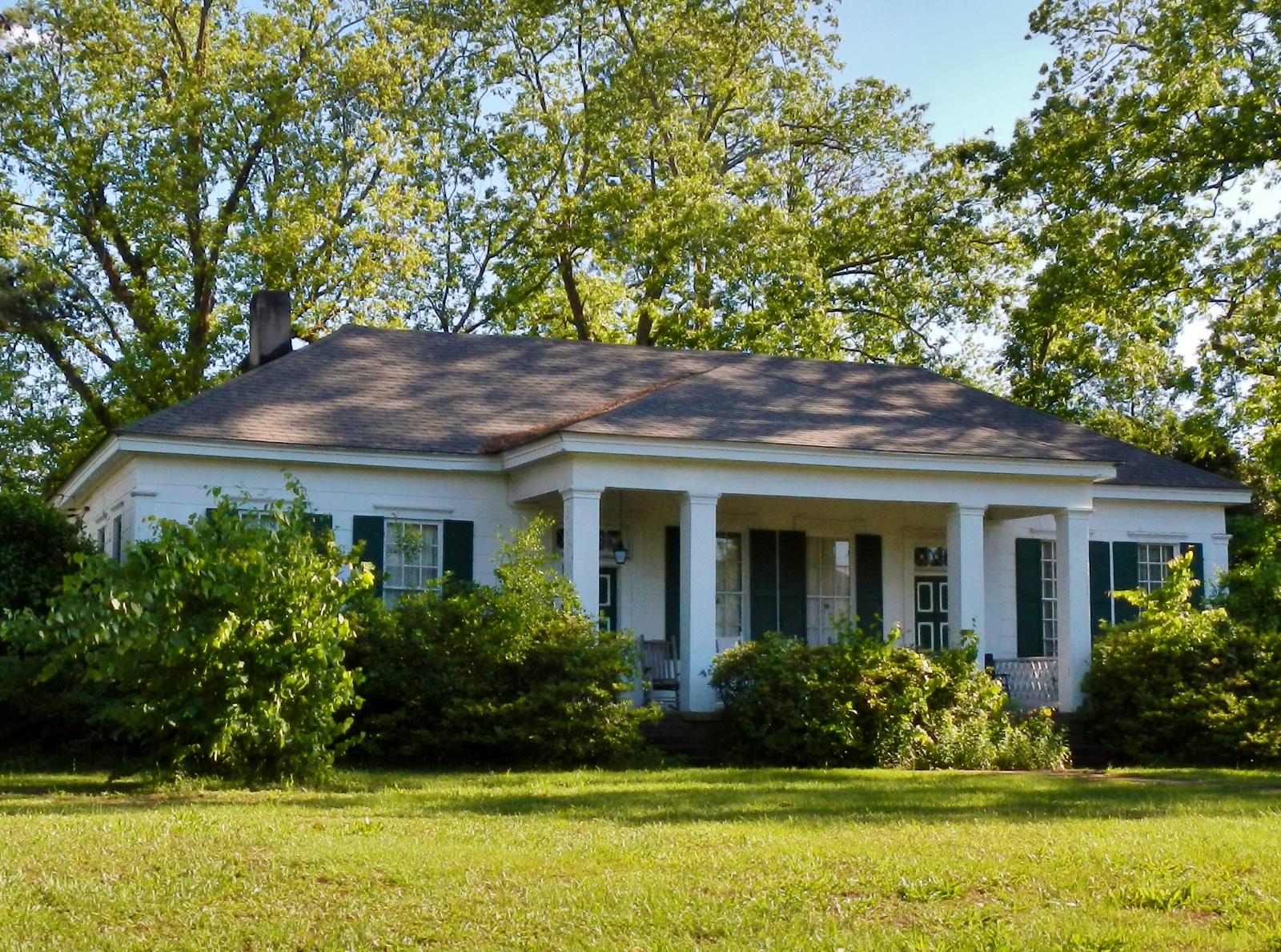
Located in Stewart County, Richland is known for its historic downtown and the Richland Rum distillery, a tourism draw in southwest Georgia. The town blends historic preservation with small-town charm, which has helped support home values. Despite being off the beaten path, Richland has quietly attracted new residents and investors over the past decade.
Housing prices remain among the lowest in the state, but the town’s upward trend suggests a more stable market than most on this list. The combination of history, culture, and affordability makes Richland a solid pick for buyers seeking character and low costs. A modest population and rural setting help keep prices from spiking too quickly.
4. Wadley – 3.2% Home Price Decline Since 2022
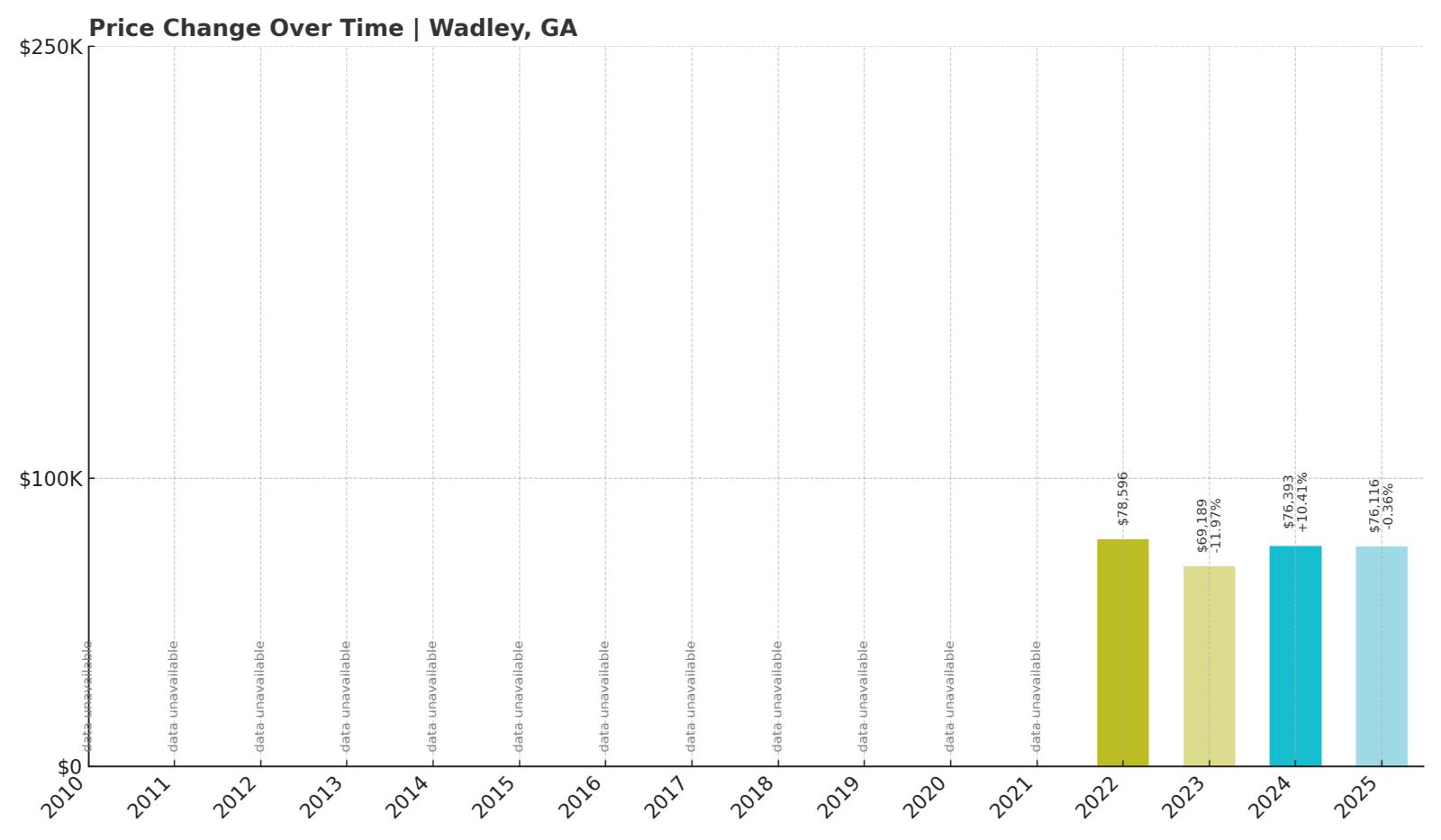
- 2010: N/A
- 2011: N/A
- 2012: N/A
- 2013: N/A
- 2014: N/A
- 2015: N/A
- 2016: N/A
- 2017: N/A
- 2018: N/A
- 2019: N/A
- 2020: N/A
- 2021: N/A
- 2022: $78,596
- 2023: $69,189 (-$9,407, -11.97% from previous year)
- 2024: $76,393 (+$7,204, +10.41% from previous year)
- 2025: $76,116 (-$277, -0.36% from previous year)
Wadley’s home prices have stayed relatively flat since 2022, with only a slight overall decline of just over 3%. After a sharp drop in 2023, the town saw a bounce back in 2024 and a minor dip in 2025 to $76,116. This recent stability sets it apart from towns experiencing more dramatic swings.
Wadley – Price Stability in Jefferson County
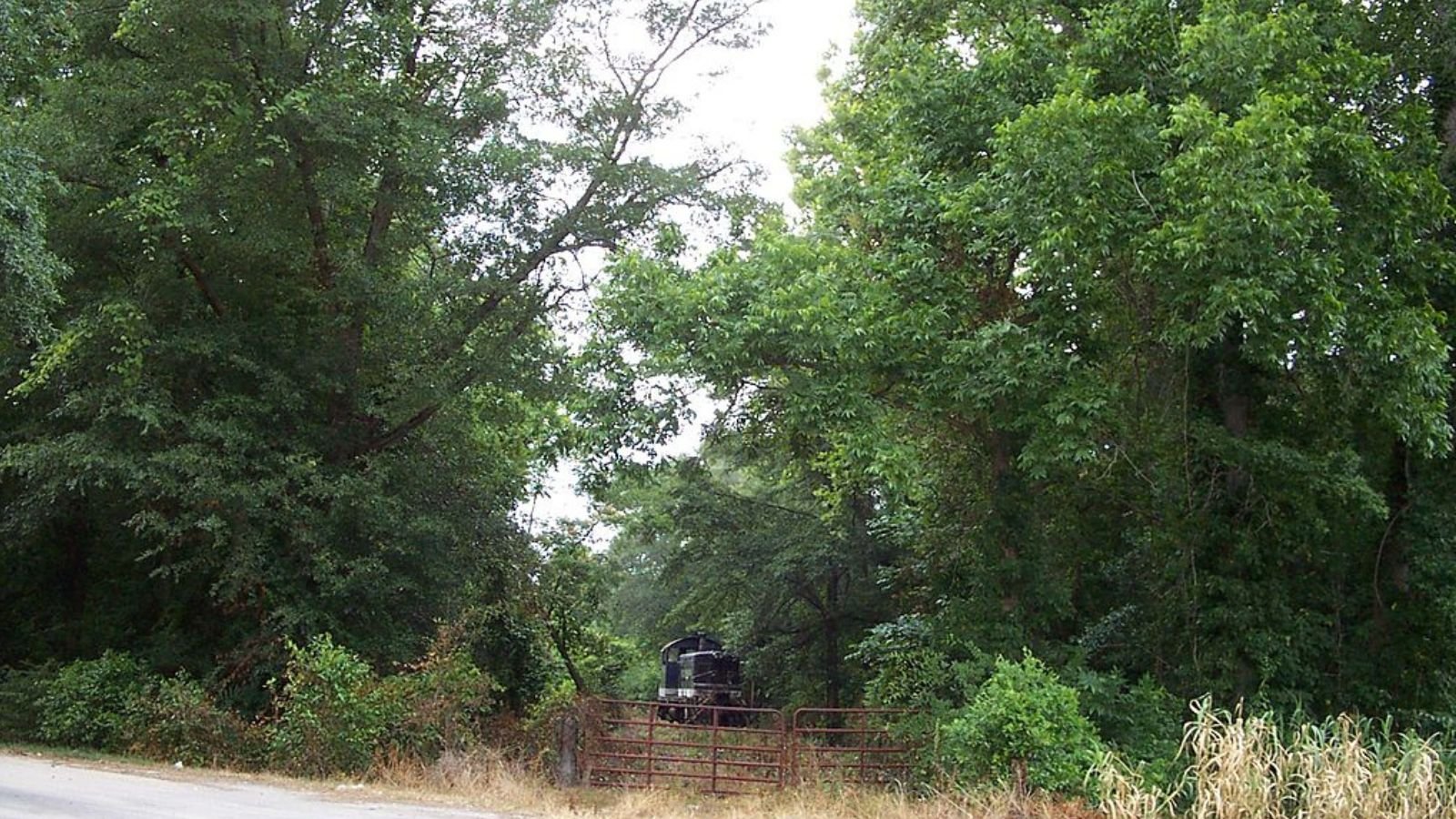
Wadley is a small town in Jefferson County between Augusta and Dublin, with fewer than 2,000 residents. It has access to key highways and a small downtown, but remains largely residential and quiet. The housing market here seems to have found a balance in recent years, avoiding major highs or lows.
With home prices holding steady around the mid-$70,000s, Wadley continues to offer some of Georgia’s most affordable real estate. Buyers looking for low entry costs with less market volatility may find it especially appealing. Its accessibility and flat pricing make it a practical option for value-focused purchases.
3. Midville – 101.3% Home Price Increase Since 2014

- 2010: N/A
- 2011: N/A
- 2012: N/A
- 2013: N/A
- 2014: $37,167
- 2015: $37,702 (+$535, +1.44% from previous year)
- 2016: $42,127 (+$4,425, +11.74% from previous year)
- 2017: $44,060 (+$1,933, +4.59% from previous year)
- 2018: $48,844 (+$4,784, +10.86% from previous year)
- 2019: $55,054 (+$6,210, +12.71% from previous year)
- 2020: $55,590 (+$536, +0.97% from previous year)
- 2021: $68,144 (+$12,553, +22.58% from previous year)
- 2022: $82,955 (+$14,812, +21.74% from previous year)
- 2023: $80,054 (-$2,901, -3.50% from previous year)
- 2024: $81,147 (+$1,093, +1.37% from previous year)
- 2025: $74,816 (-$6,331, -7.80% from previous year)
Midville has seen prices more than double since 2014, even with a recent drop in 2025 to $74,816. After peaking in 2022, prices have dipped slightly, but the overall trend remains upward. It’s one of the few towns on this list with strong long-term growth and continuing affordability.
Midville – Burke County’s Quiet Climber
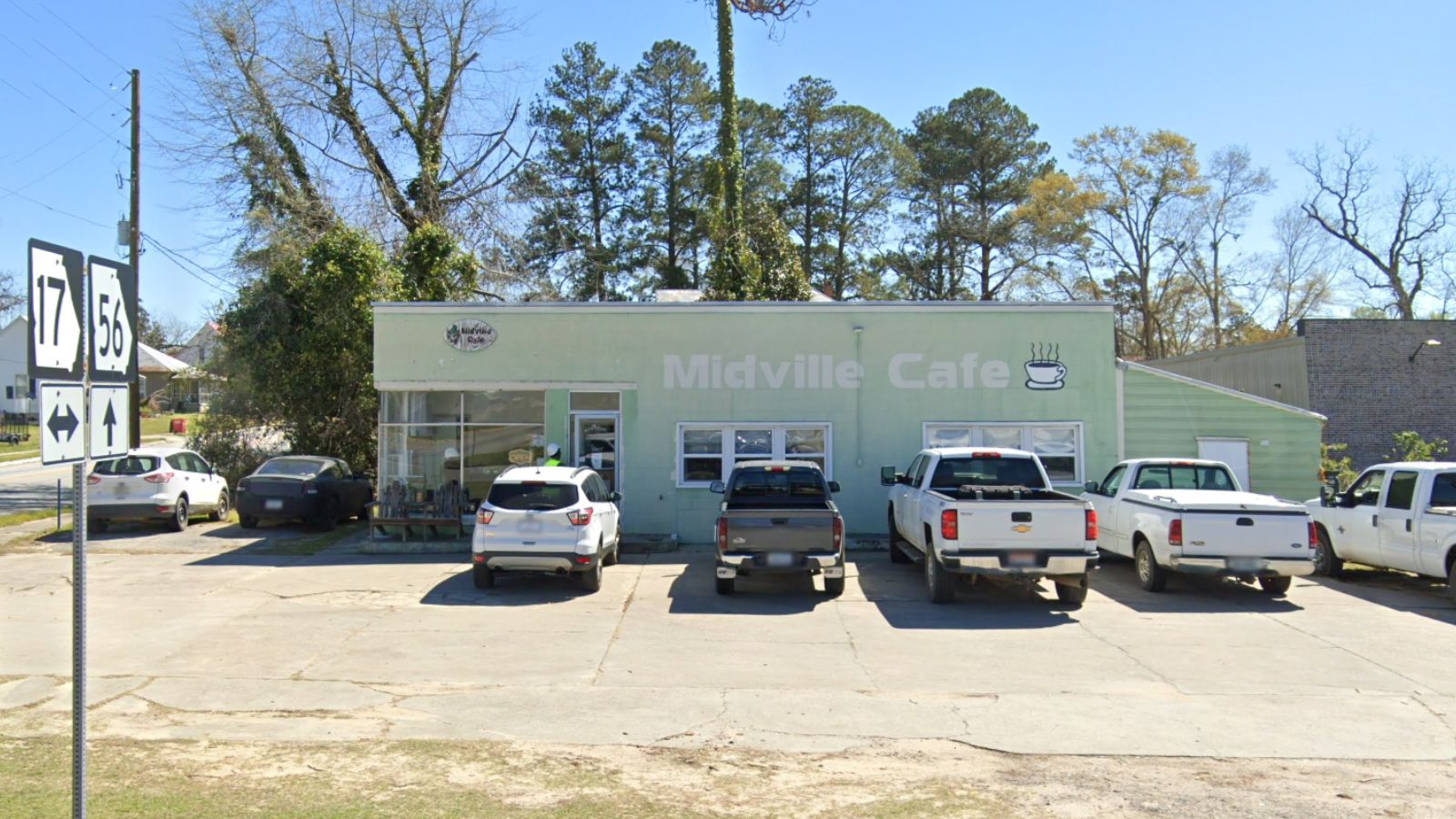
Midville is a tiny city in Burke County near the Ogeechee River, surrounded by farmland and forest. While small in size and population, its real estate market has quietly doubled in value over the past decade. Its location between Augusta and Statesboro provides regional access while keeping home prices low.
Though the market has cooled slightly in the past year, prices remain near their all-time highs. That combination of long-term growth and continued affordability makes Midville an outlier. It’s a compelling choice for those seeking rising values in a rural environment.
2. Lumpkin – 84.1% Home Price Increase Since 2010
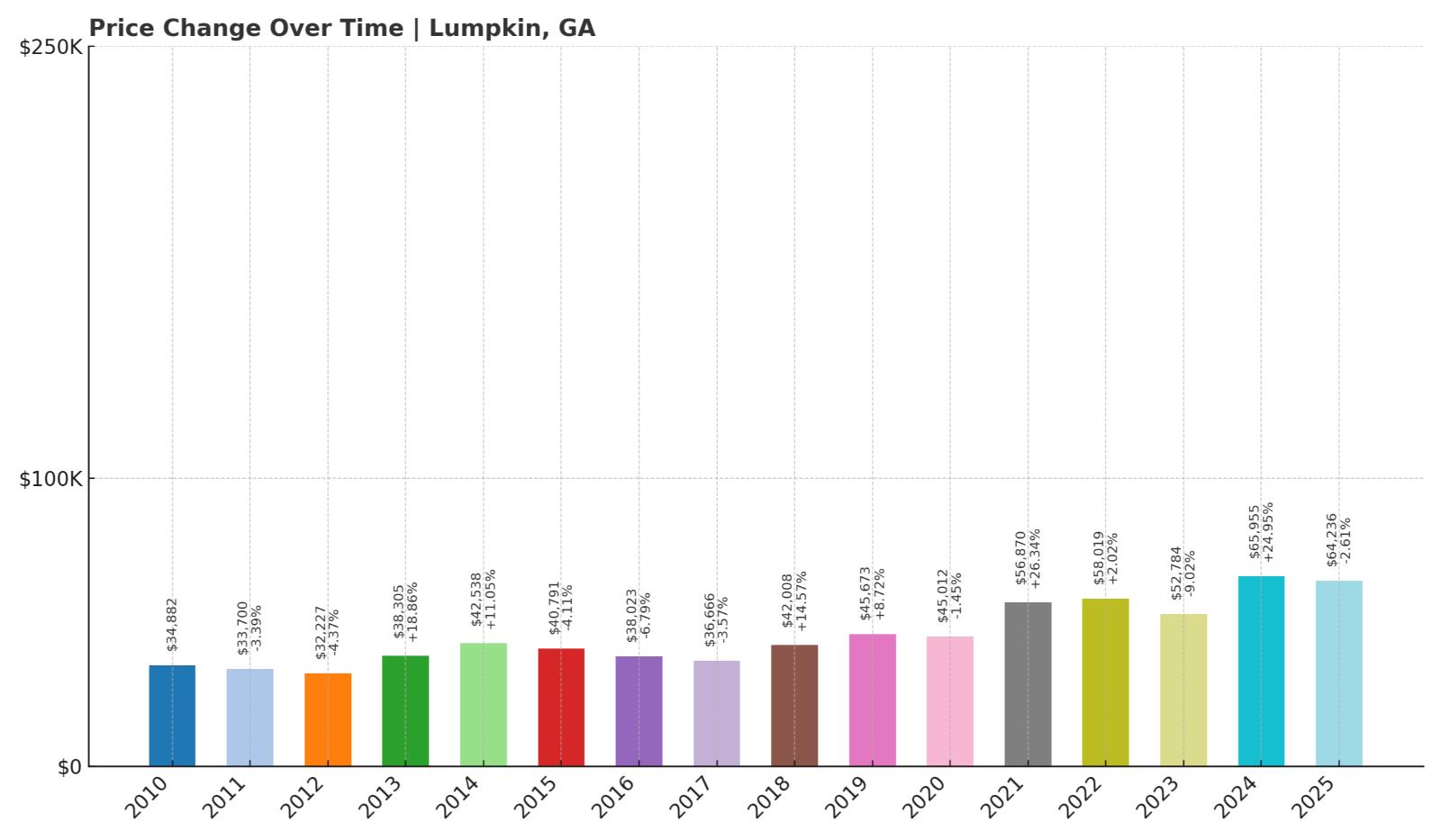
- 2010: $34,882
- 2011: $33,700 (-$1,182, -3.39% from previous year)
- 2012: $32,227 (-$1,473, -4.37% from previous year)
- 2013: $38,305 (+$6,078, +18.86% from previous year)
- 2014: $42,538 (+$4,233, +11.05% from previous year)
- 2015: $40,791 (-$1,747, -4.11% from previous year)
- 2016: $38,023 (-$2,768, -6.79% from previous year)
- 2017: $36,666 (-$1,357, -3.57% from previous year)
- 2018: $42,008 (+$5,342, +14.57% from previous year)
- 2019: $45,673 (+$3,665, +8.72% from previous year)
- 2020: $45,012 (-$661, -1.45% from previous year)
- 2021: $56,870 (+$11,858, +26.34% from previous year)
- 2022: $58,019 (+$1,149, +2.02% from previous year)
- 2023: $52,784 (-$5,235, -9.02% from previous year)
- 2024: $65,955 (+$13,171, +24.95% from previous year)
- 2025: $64,236 (-$1,720, -2.61% from previous year)
Since 2010, home values in Lumpkin have climbed over 84%, rising from just under $35,000 to $64,236 in 2025. That growth has come with volatility, including sharp price drops in 2020 and 2023. Still, the town remains near the bottom in terms of absolute price, making it highly affordable.
Lumpkin – Growth With Volatility in Stewart County
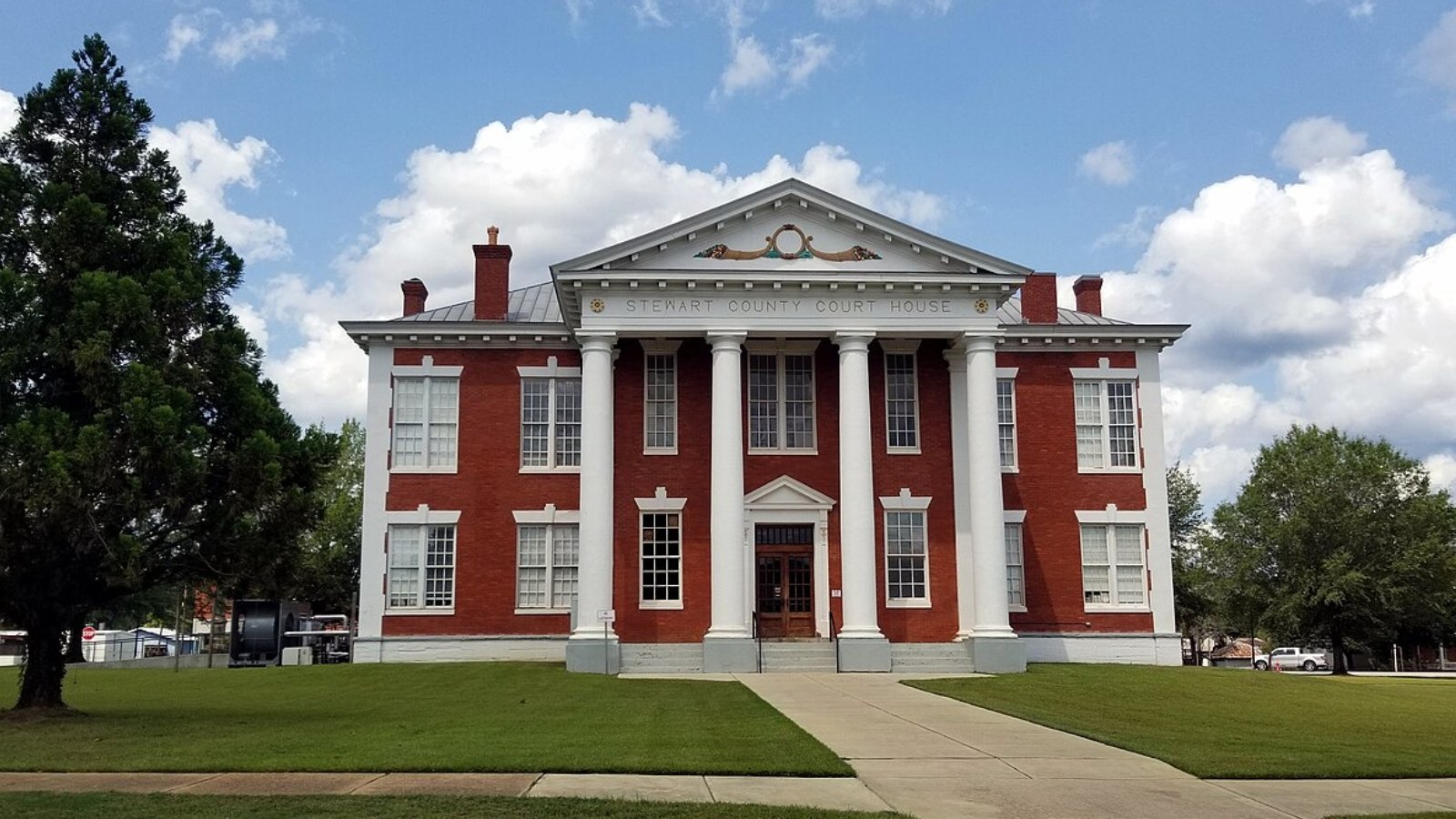
Lumpkin is the county seat of Stewart County in west Georgia, near the Alabama border. The town is best known as home to Westville, a living history museum, and the Stewart Detention Center, one of the area’s largest employers. Its economy is limited, but the local housing stock remains low-priced and accessible.
Despite its ups and downs, Lumpkin’s housing market shows clear long-term appreciation. The low prices combined with major swings make it a high-risk, high-reward market for investors. For homebuyers on a tight budget, the town offers opportunities that remain far below state averages.
1. Cuthbert – 80.1% Home Price Increase Since 2010
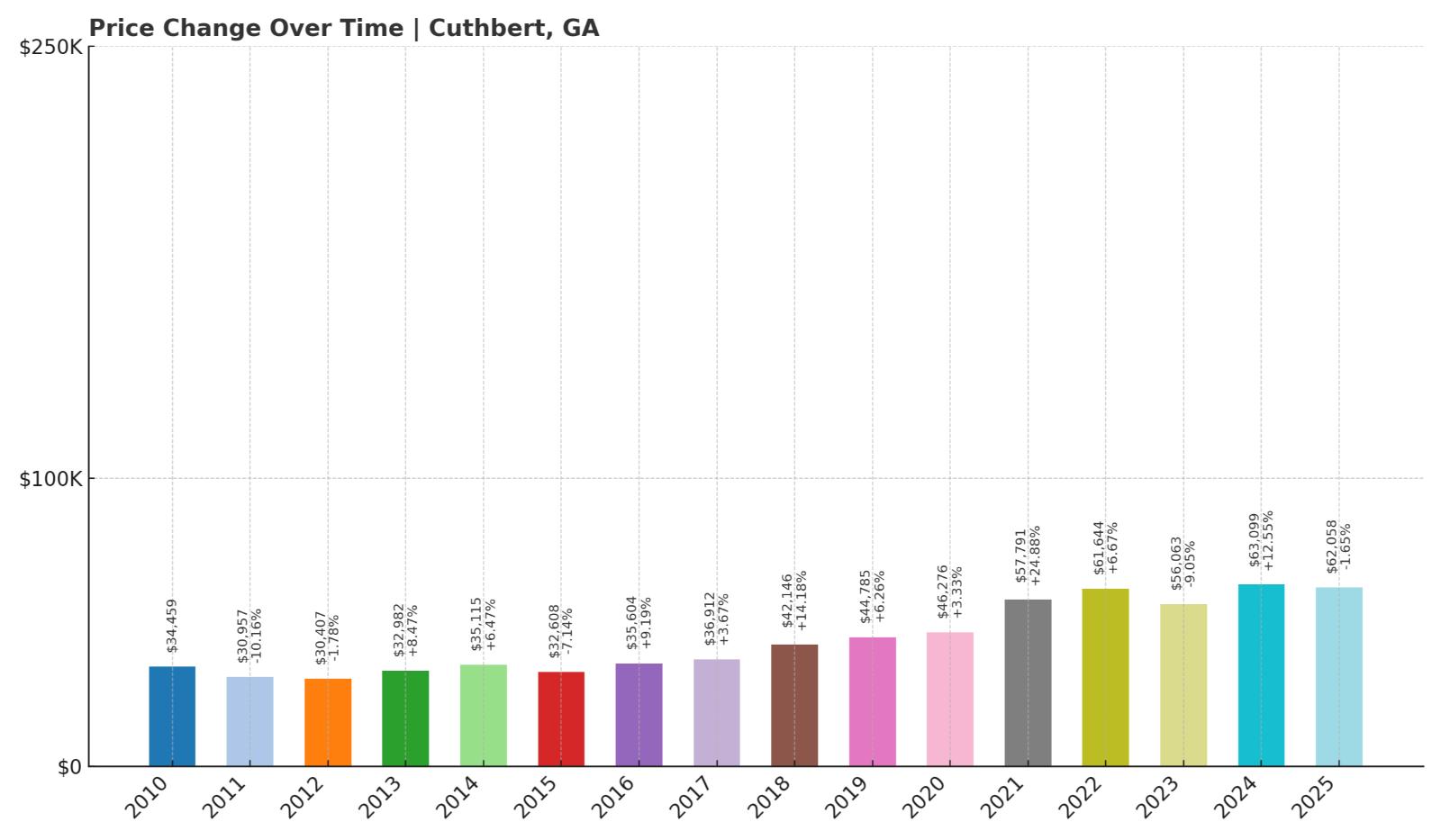
- 2010: $34,459
- 2011: $30,957 (-$3,502, -10.16% from previous year)
- 2012: $30,407 (-$549, -1.77% from previous year)
- 2013: $32,982 (+$2,575, +8.47% from previous year)
- 2014: $35,115 (+$2,133, +6.47% from previous year)
- 2015: $32,608 (-$2,508, -7.14% from previous year)
- 2016: $35,604 (+$2,997, +9.19% from previous year)
- 2017: $36,912 (+$1,308, +3.67% from previous year)
- 2018: $42,146 (+$5,234, +14.18% from previous year)
- 2019: $44,785 (+$2,639, +6.26% from previous year)
- 2020: $46,276 (+$1,492, +3.33% from previous year)
- 2021: $57,791 (+$11,515, +24.88% from previous year)
- 2022: $61,644 (+$3,853, +6.67% from previous year)
- 2023: $56,063 (-$5,582, -9.05% from previous year)
- 2024: $63,099 (+$7,036, +12.55% from previous year)
- 2025: $62,058 (-$1,041, -1.65% from previous year)
Home prices in Cuthbert have climbed from $34,459 in 2010 to $62,058 in 2025—a total increase of over 80%. Though prices dipped in 2023 and again slightly in 2025, the town has shown strong long-term appreciation. Cuthbert now ranks as the most affordable town in Georgia despite these gains.
Cuthbert – Georgia’s Cheapest Housing Market
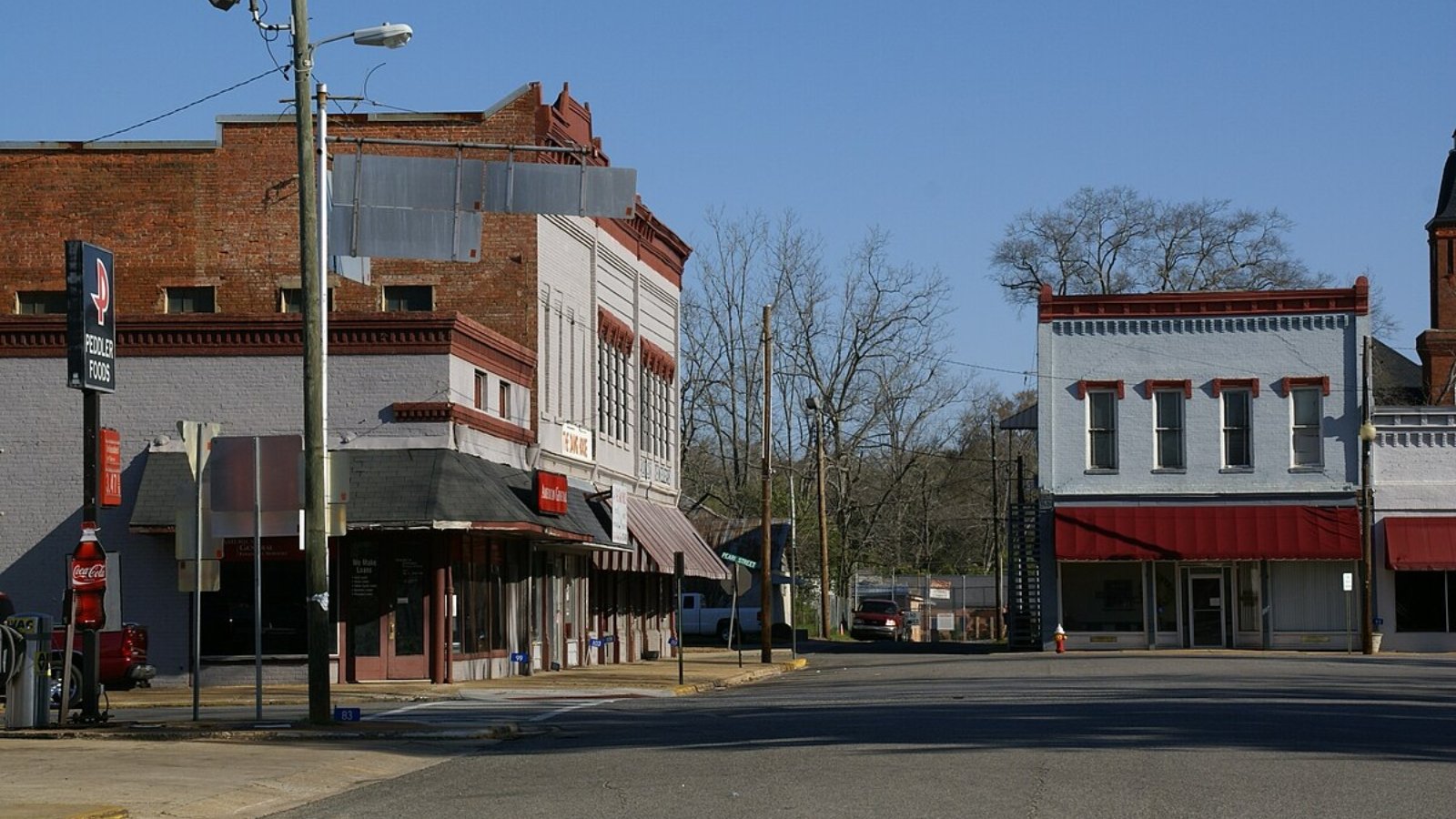
Cuthbert is the seat of Randolph County in southwest Georgia, with a small-town atmosphere and deep historical roots. Once a key cotton hub, the town today is quiet and largely residential, anchored by Andrew College and several preserved historic sites. Its location near the Alabama border keeps it rural and secluded.
While economic development is limited, Cuthbert’s housing prices remain the lowest in the state. Buyers who prioritize cost above all else will find few better deals. Its slow pace of life and small-town charm may also appeal to retirees and remote workers.


